Famous Egypt landmarks that unarguably will make your trip to Egypt unforgettable!
This collection of spectacular Egyptian landmarks covers ancient Egyptian sites from the sensational Giza Pyramid complex and glorious ancient Egyptian temples of Abu Simbel, Kom Ombo, Philae, and Edfu to unique Roman catacombs in Alexandria and biblical Mt Sinai. The list of Egypt’s famous landmarks sums up the most beautiful places in Egypt, top things to see in Egypt, Egypt’s points of interest, the best places in Egypt to see, obligatory places to go in Egypt, most important archeological sites of Egypt, and most interesting Egypt destinations.
Find out where to go in Egypt, what to see in Egypt, and what to do in Egypt!
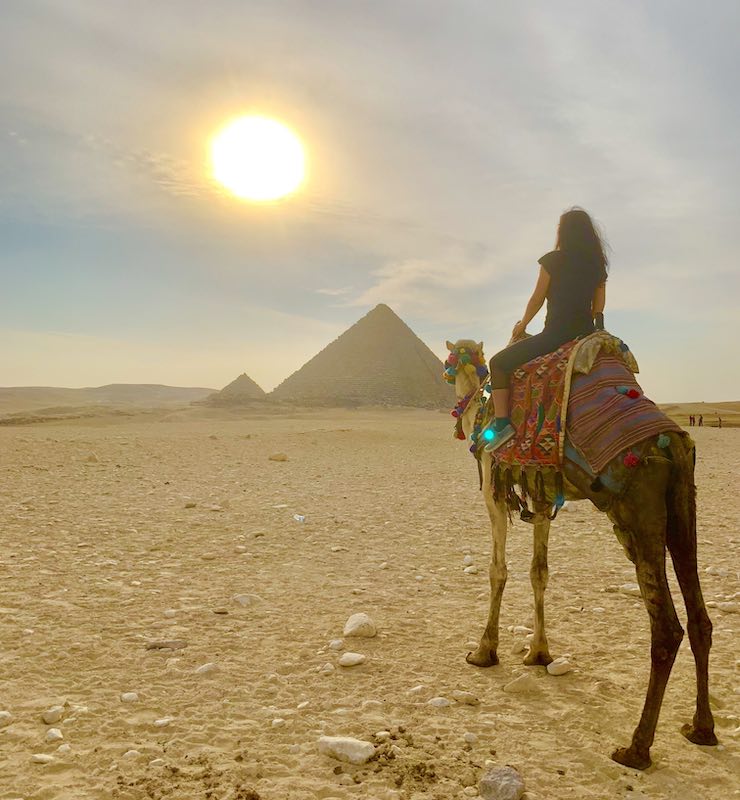
Famous Egypt Landmarks: 30 Must-See Landmarks in Egypt for Your Ultimate Egypt Bucket List
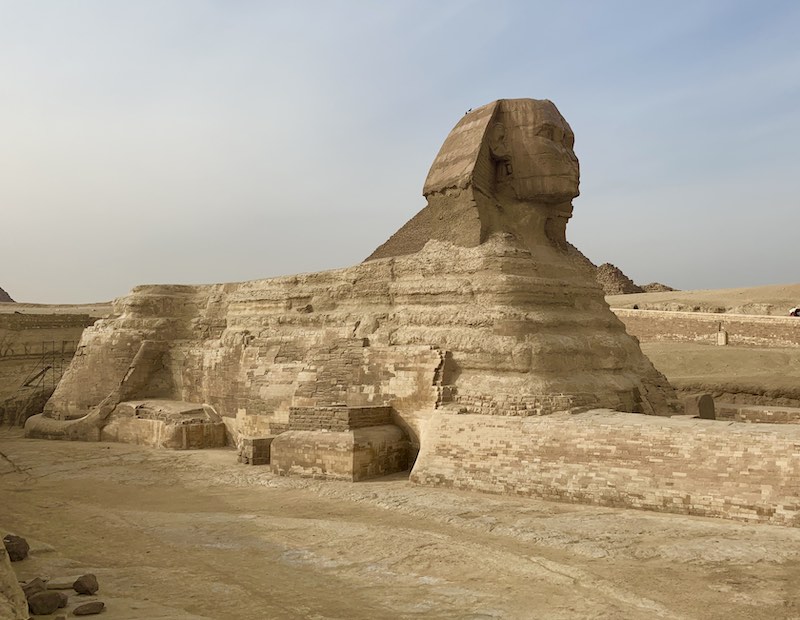
THIS POST MAY CONTAIN COMPENSATED LINKS. PLEASE READ MY DISCLAIMER FOR MORE INFO.
INTRODUCTION ABOUT FAMOUS LANDMARKS IN EGYPT
This collection of must-see landmarks in Egypt covers the most important monuments in Egypt, the most famous landmarks in ancient Egypt, the landmarks Egypt is known for, manmade landmarks of Egypt, and natural landmarks of Egypt.
Landmarks of Egypt:
1. The Great Pyramid of Giza
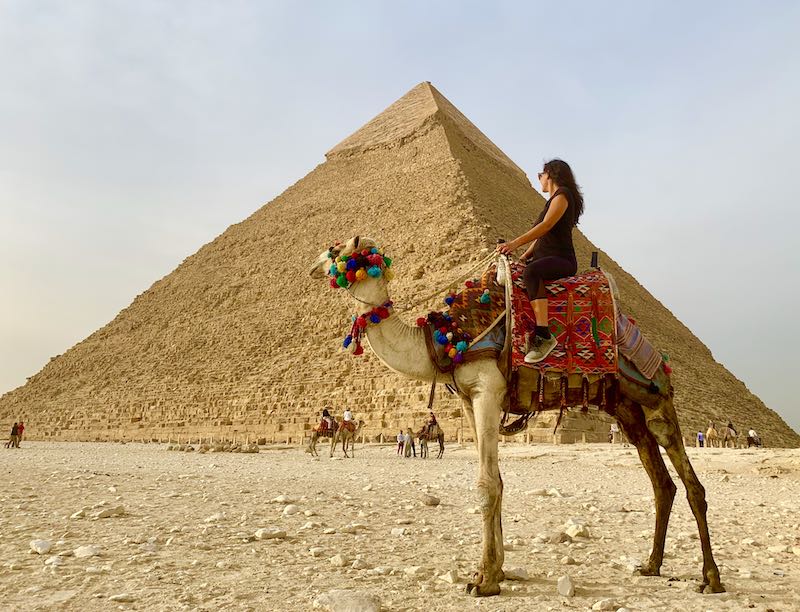
This ultimate Egypt bucket list of outstanding Egyptian landmarks starts with what else but Egyptian pyramids.
And for a good reason. When someone mentions Egypt, the ancient pyramids are likely to be the first on everyone’s mind. Travelers to Egypt want to see ancient mysteries. Mysteries are tempting and irresistible. Especially, ancient ones.
The Great Pyramid of Giza is the only remaining wonder of the Seven Wonders of the Ancient World. And everyone wants to see the only still lasting mystery of the Ancient World.
The Great Pyramid of Giza is the oldest pyramid and the largest pyramid in Giza. The Great Pyramid of Giza was built as the tomb of Pharaoh Khufu (also called Cheops).
The Great Pyramid of Cheops is the oldest pyramid in Giza, dating back to around 2.550 BC. Yes, please note that the Cheops Pyramid is roughly 4.570 years old!
The 497 ft (146 m) tall Great Pyramid of Giza is the tallest manmade structure in the Ancient World. It was the tallest structure in the World for about the next 3.800 years – until 1.300 when the 489 ft (149 m) tall old St Paul Cathedral in London was built and that stood once on the site of present-day St Paul Cathedral in London.
Just to add here, in case you are wondering now, today’s tallest building in the world is the 2.717 ft (828 m) tall Burj Khalifa in Dubai.
General entrance fee to the Pyramids of Giza: 540 EGP (10,63 USD) adult, 270 EGP (5,31 USD) student
Opening hours: 7 am to 5 pm
Entrance fee to the Pyramid of Khufu: 900 EGP (17,71 USD) adult, 450 EGP (8,86 USD) student
Opening hours: 7 am to 6 pm (closed noon – 1 pm)
Climbing the pyramids is not allowed. Cameras in the pyramids are not allowed.
2. The Pyramid of Kaphre in Giza
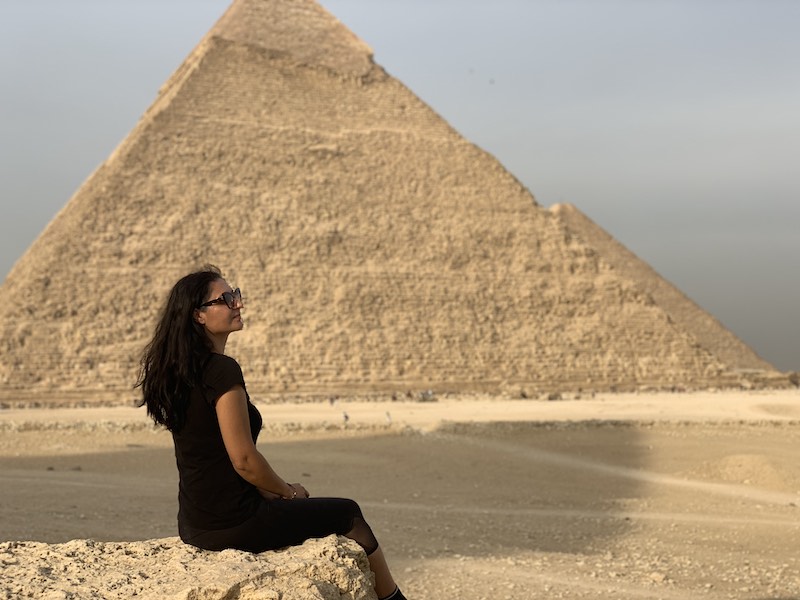
The Great Pyramid of Giza is not the only pyramid in Giza.
The Giza pyramid complex includes three major pyramids: the Great Pyramid of Cheops/Khufu, the Pyramid of Khaphre, and the Pyramid of Menkaure.
The Great Pyramid of Cheops (the Great Pyramid of Giza) is the tallest pyramid in Egypt and the Pyramid of Khaphre is the second tallest pyramid in Egypt.
The Khaphre pyramid was built during the reign of Pharaoh Khaphre, a son of Pharaoh Cheops. Pharoh Khaphre was the fourth king of the fourth dynasty of the Old Kingdom and the Pyramid of Khaphre was built around 2570 BC.
3. The Pyramid of Menkaure in Giza

The Pyramid of Menkaure is the smallest pyramid in Giza.
The Pharoh Menkaure is doubted to be the son of Cheops or Khaphre. Menkaure was the fifth king of the 4th dynasty of the Old Kingdom, and the Pyramid of Menkaure was built around 2510 BC.
There is no need to point out that the Giza pyramids complex is a UNESCO World Heritage site in Egypt and that the Giza pyramids are the most famous pyramids in Egypt. (Giza pyramids are not the only pyramids in Egypt. There are about 200 currently known pyramids in Egypt.)
The pyramids at Giza are an obligatory stop for all aficionados of World Heritage sites on their Egypt tour.
Visiting the spectacular Giza pyramids complex is one of the best things to do in Egypt!
Entrance fee to the Pyramid of Menkaure: 220 EGP (4,33 USD) adult, 110 EGP (2,17 USD) students
Take a tour to visit the Giza pyramids: Book this tour and visit Giza Pyramids with a qualified Egyptologist, ride a camel, have lunch, and have a hotel pick-up and drop-off!
Recommended stay in Giza:
Le Meridien Pyramids Hotel Cairo,
Safir Hotel Cairo
4. The Great Sphinx of Giza
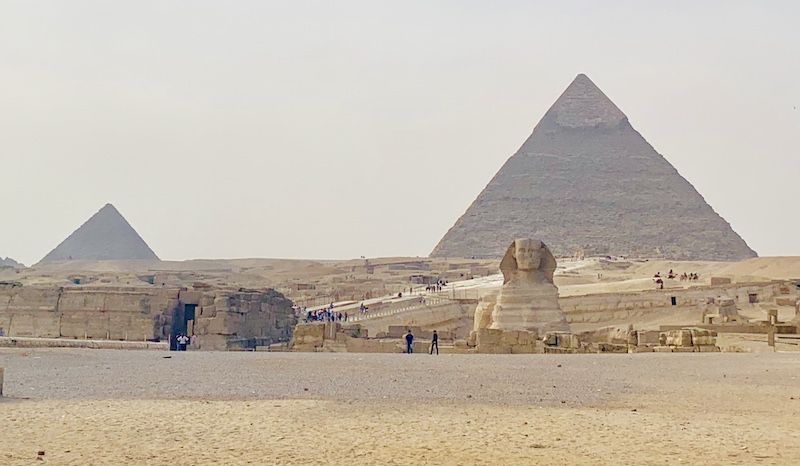
Just in front of the Pyramids in Giza stands another famous Egypt landmark – the Great Sphinx of Giza.
The Great Sphinx of Giza is a statue of a mythical creature with a lion’s body and a human’s head. The Sphinx was a spiritual guardian of the Pharaon’s tomb – the pyramid.
The face of the Great Sphinx in Giza is assumed to represent the face of Pharaoh Khaphre.
The Great Sphinx is one of the oldest statues in the World dating back to the Old Kingdom of Egypt and the Pharaoh Khaphre’s times (about 2.500 BC). The Sphinx in Giza is also one of the largest statues in the World as it is 238 ft (73 m) long and 68 ft (20 m) tall.
Entrance fee to the Sphinx (Private Visits only + Site Opening Fee): 200 (3,94 USD) EGP
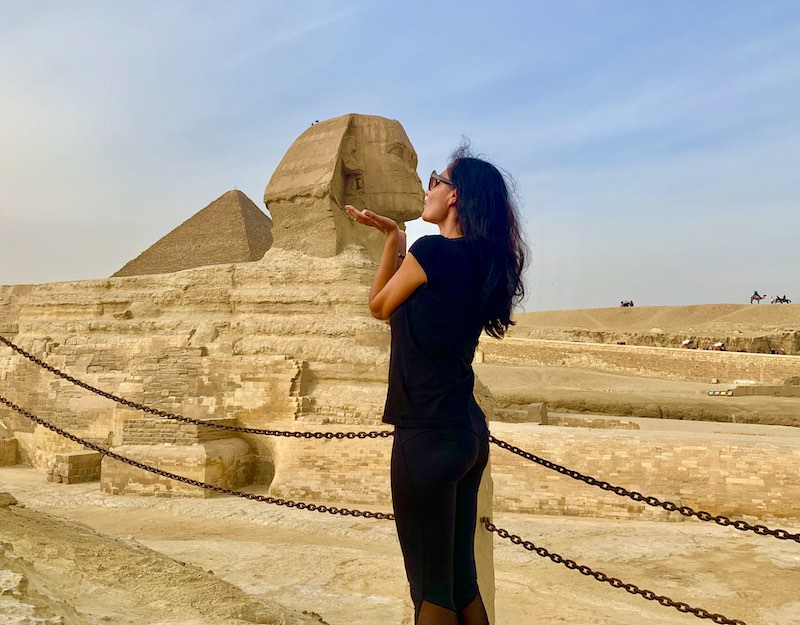
Take a tour and visit the Great Sphinx and pyramids from Cairo:
Giza pyramids and Sphinx Half-Day Private Tour
Recommended stay in Giza:
Egypt Pyramids Inn, Le Meridien Pyramids Hotel Cairo, Safir Hotel Cairo
Where is Giza?
Giza is a small town on the outskirts of Cairo, about 8 m (13 km) from Cairo’s downtown.
How to get to Giza?
The Giza pyramids-Sphinx complex is easily reachable from Cairo Downtown: by public CTA (Cairo Transport Authority) bus No 355 and No 357 from Tahrir Square next to the Egyptian Museum, by a taxi (white and yellow), Uber, or metro. Metro Line 2 drives from the Sadat station at Tahrir Square to El-Giza station.
5. Pyramid of Djoser in Saqqara
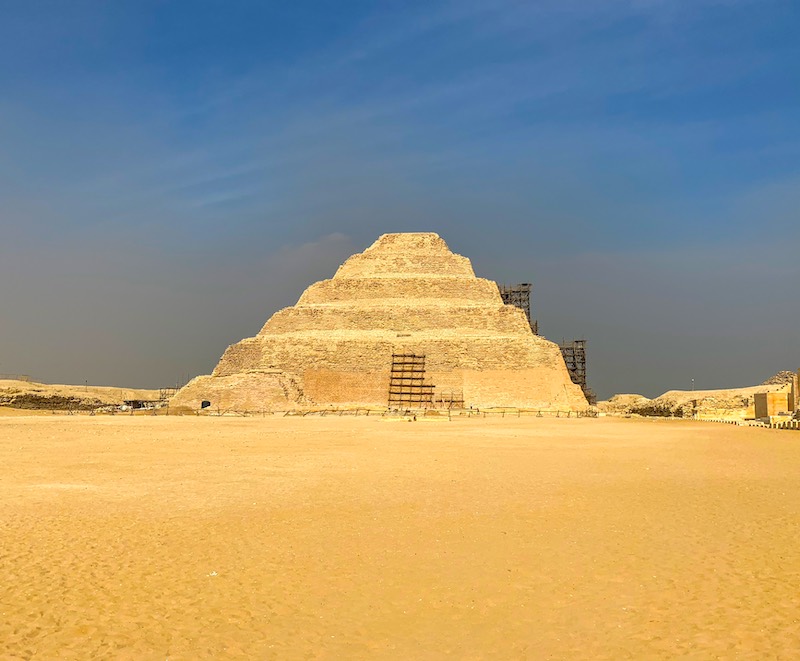
The stepped pyramid of Djoser in Saqqara necropolis is another must-see Egyptian landmark.
The Step Pyramid is the earliest monumental pyramid in Egypt! The Step Pyramid of Djoser is a proto-pyramid.
Please note, that the Step Pyramid is older than the Giza pyramids. It was built by the great ancient Egyptian architect Imhotep in the 27th century BC as the burial site of pharaoh Djoser.
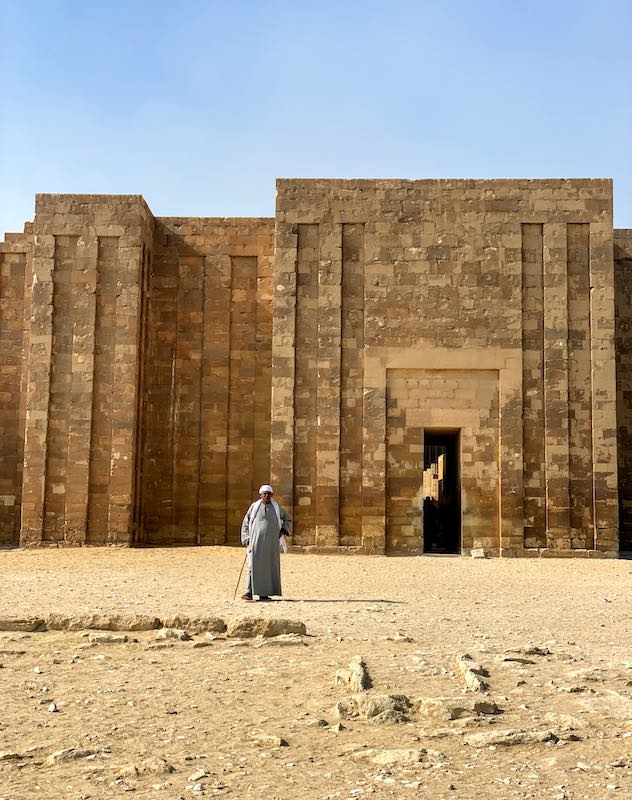
Let me add that some of the most famous ancient Egyptian necropoles (burial sites in ancient Egypt) are Sakkara necropolis, Abusir necropolis, Dahsur necropolis, and Giza necropolis.
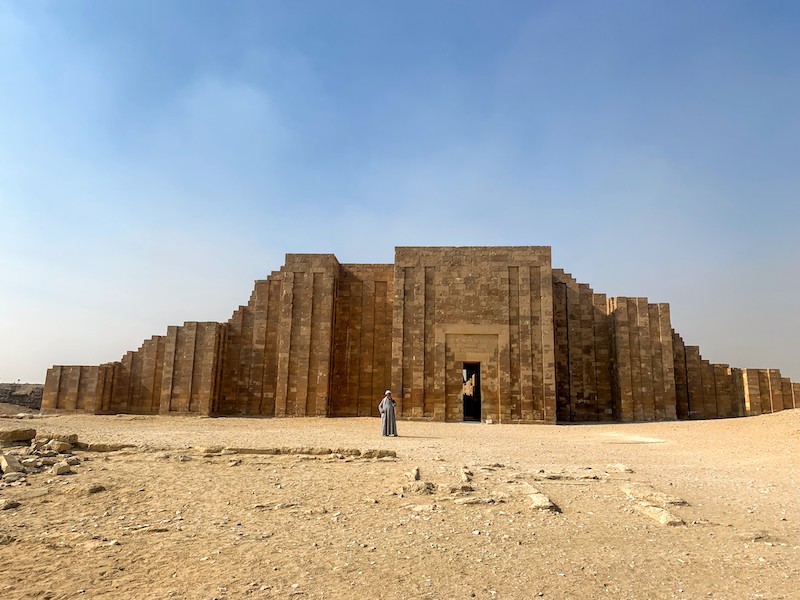
Saqqara necropolis was the burial site of the ancient Egyptian capital of Memphis, located about 19 mi (30 km) south of Cairo.
Entrance fee to Saqqara (Includes pyramid of Djoser Complex, the pyramid of Unas, the pyramid of Teti, and tombs of Kagemni, Nikauisesi, Ankhmahor, Neferseshemptah, Ptahhotep, Idut, Unasankh, and Iynefert & Imhoteb Museum): 450 EGP (8,86 USD) adult, 230 (4,53 USD) EGP student
Entrance fee to Step Pyramids: 220 EGP (4,33 USD) adult, 110 EGP (2,17 USD) student
Visit beyond Giza pyramids, and see Memphis and Sakkara necropolis. Check out:
Giza Pyramids, Memphis, and Sakkara – Day Tour from Cairo
Private All Inclusive Tour: Giza Pyramids, Sphinx, Memphis, Saqqara, Lunch & Camels.
Where is the Saqqara necropolis?
The Saqqara necropolis is 20 mi (32 km) south of Cairo.
How to visit the Pyramid of Djoser and the Saqqara necropolis?
Hire a taxi or take a guided tour. Check out Private All Inclusive Tour: Giza Pyramids, Sphinx, Memphis, Saqqara, Lunch & Camels.
6. Red Pyramid in Dashur
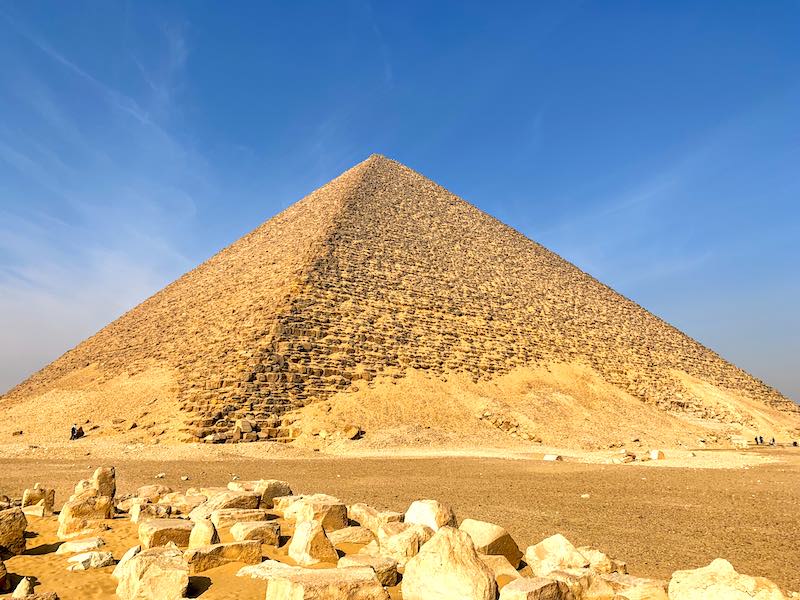
The Red Pyramid in Dahsuhur necropolis near Cairo is another important Egyptian landmark since it was the first ‘true pyramid’ with even sides.
The Red Pyramid is the third tallest pyramid in Egypt. Only the Great Pyramid of Cheops and the Pyramid of Khaphre in Giza are taller than the Red Pyramid.
This ancient Egyptian pyramid was built by Pharaoh Sneferu, the father of Pharaoh Cheops (who built the Great Pyramid of Giza) and the grandfather of Pharaoh Khaphre. In other words, only his son and grandson made taller pyramids than he had.
If you want to enter a pyramid to feel what it looks like inside it, I recommend going inside the Red Pyramid. A good thing is, that you don’t need to pay any extra fee for entering the Red Pyramid. Entering the Red Pyramid is free, unlike entering the Pyramids of Giza. This was the pyramid I entered on my trip to Egypt.
Entrance fee to Dashur Necropolis: 150 EGP 82,95 USD) adult, 75 EGP (1,48 USD) student
Opening times: 8 am to 5 pm
Where is the Dashur Necropolis?
The Dashur necropolis is 25 mi (40 km) south of Cairo.
How to visit the Red Pyramid and the Dashur Necropolis?
Hire a taxi or take a guided tour.
7. Egyptian Museum in Cairo
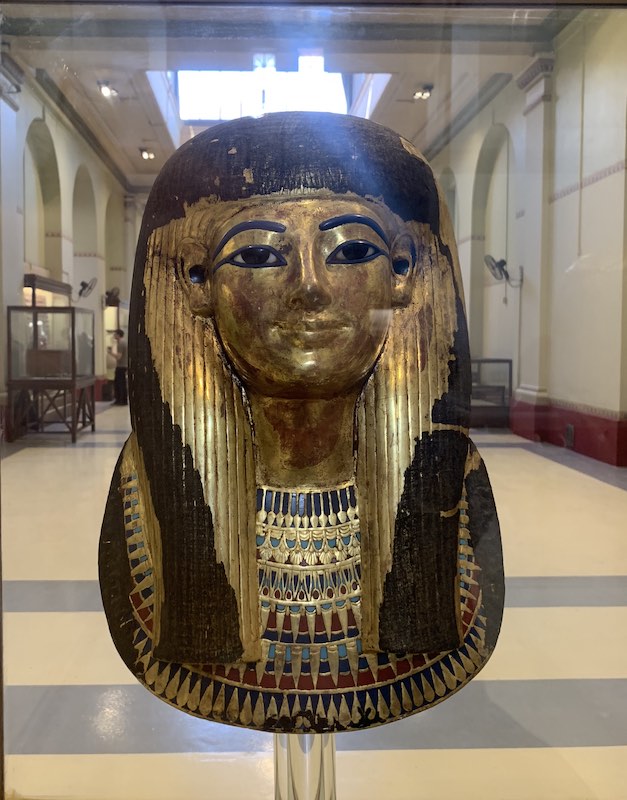
The next extraordinary landmark in Egypt and one of the most famous buildings in Egypt is the Egyptian Museum in Cairo.
The Egyptian Museum is a ‘pilgrimage site’ for all addicts of ancient history. The Museum of Egyptian Antiquities is home to about 120,000 artifacts from ancient Egypt located in downtown Cairo.
Here you can see the largest collection of ancient Egyptian items (jewelry, pottery, treasuries, and mummies) in the World. In the Museum devotees of Ancient Egypt will find the gold death mask and sarcophagus of the beloved King Tutankhamun. Here is the place where the visitors observe with respect the Egyptian mummies in the Mummy Room. No, the mummies are not frightening. They are just storytellers of a glorious ancient civilization.
Visit Egyptian Museum in Cairo:
4-Hour Guided Tour of the Egyptian Museum
Egyptian Museum of Antiquities Entrance Ticket
Pyramids of Giza and Egyptian Museum – Full Day Tour
Entrance fee to the Egyptian Museum & Mummy Room: 450 EGP (8,86 USD) adult, 230 EGP ( 4,53 USD) student
Opening hours of the Egyptian Museum: 9 am – 7 pm; Fri 9 am – 11 am, 1:30 pm – 7 pm
Recommended stay in Cairo:
Midan Tahrir – The Nile Ritz-Carlton Cairo,
Downtown Cairo – Steigenberger Hotel
Zamalek – Wake-Up! Cairo Hostel, New President Hotel Zamalek
Giza – Egypt Pyramids Inn, Safir Hotel Cairo
8. Abu Simbel temple
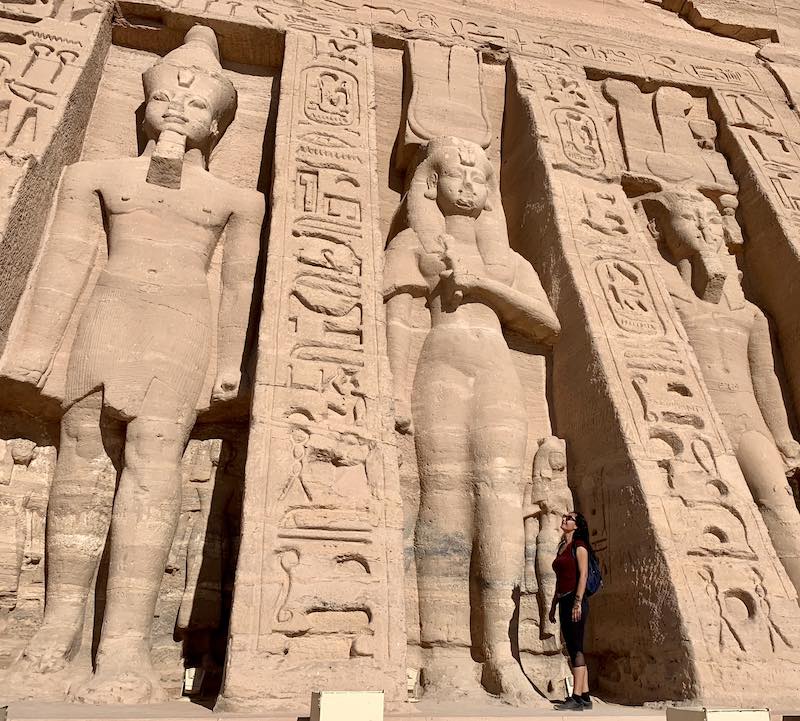
What is Egypt known for?
Egypt is best known for ancient Egyptian pyramids, but also for ancient Egyptian temples.
The Abu Simbel temple is one of the most famous ancient Egyptian temples. It is a jaw-dropping ancient Egyptian temple from the 13th century BC and a must-see temple landmark in Egypt.
The Abu Simbel complex includes two temples built by Ramesses II: the Great Temple and the Small Temple.
The Great Temple is dedicated to Ramesses II and to the gods Ra-Horatky (the god of the Sun, Earth, and Underworld) and Ptah (the god of the Underworld).
The Small Temple is dedicated to Ramesses’ wife Queen Nefertari and to the goddess Hathor (the major goddess in ancient Egypt).
Colossi of Ramesses and Nefertari of Abu Simbel temple are of the same size, showing the same importance of the king and the queen. That was not common in ancient Egypt as queens were usually pictured as smaller in size than kings (pharaohs) marking the significant difference in their roles and authorities.
The Abu Simbel temples were cut off the sea cliff and carved out of it. Over time the Abu Simbel temples got covered by sand and were rediscovered in the 19th century.
Where is Abu Simbel?
Abu Simbel temple is located in the Nubian village of Abu Simbel on Lake Nasser in southern Egypt, 143 mi (230 km) southwest of the town of Aswan and near the border with Sudan.
How to visit the Abu Simbel temple?
Take a guided tour from Aswan (there are daily tours), take a 30-min flight from Aswan to Abu Simbel (there are two flights a day!), or join a Lake Nasser cruise (Lake Nasser Cruise ships anchor in front of the temple) and visit Abu Simbel temple.
Visiting Abu Simbel temple from Aswan or from Luxor:
Abu Simbel from Aswan – Private Tour
Abu Simbel included 7-Night Nile river cruise starting and ending in Luxor
Recommended stay in Aswan:
Sofitel Legend Old Cataract, Mövenpick Resort Aswan
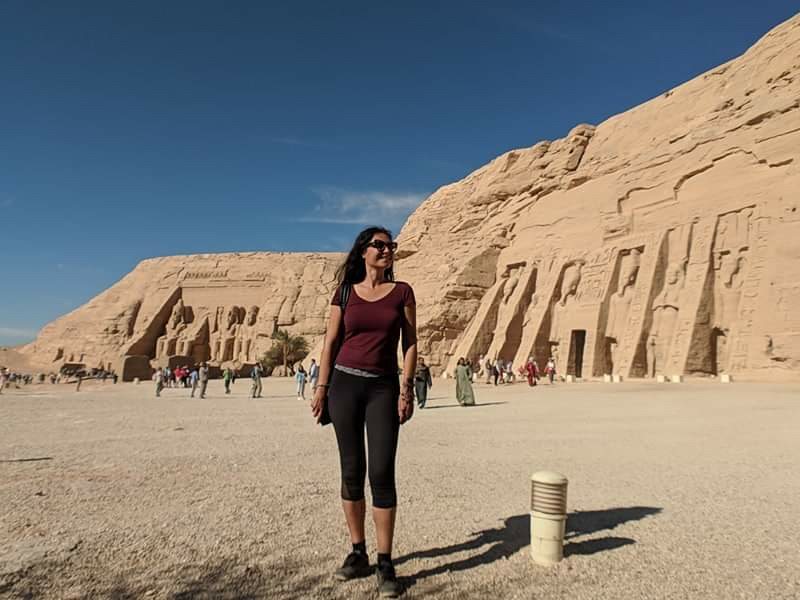
Entrance fee to the Abu Simbel Temple: 600 EGP (11,81 USD) adult, 300 EGP (5,91 USD) student
Opening times: 6 am – 5 pm
9. Temple of Kalabsha (Temple of Mandulis)
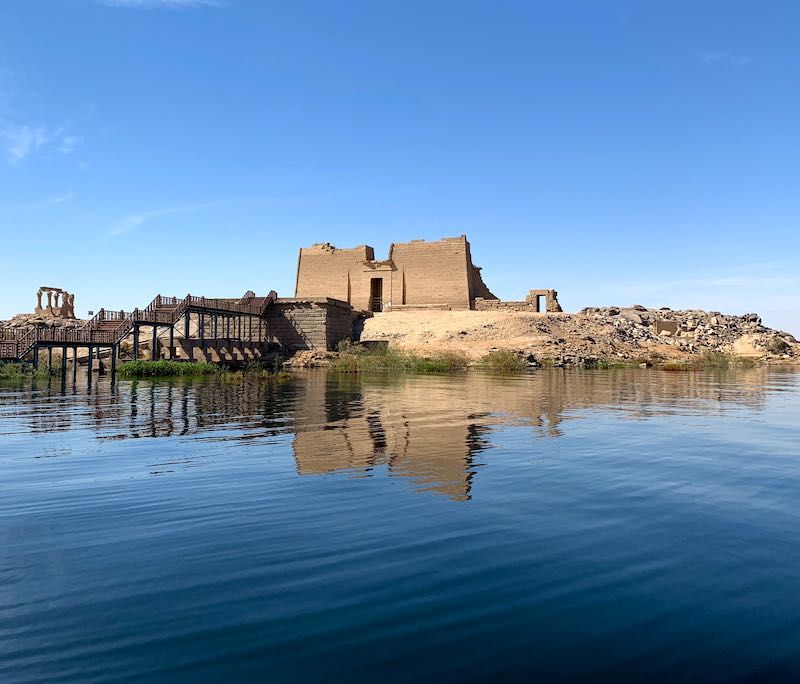
The Temple of Kalabsha is a famous ancient Egyptian temple and a landmark in Egypt too.
It is a beautiful ancient Egyptian temple on a small island in the Nasser Lake near Aswan Dam in southern Egypt close to the border between Egypt and Sudan.
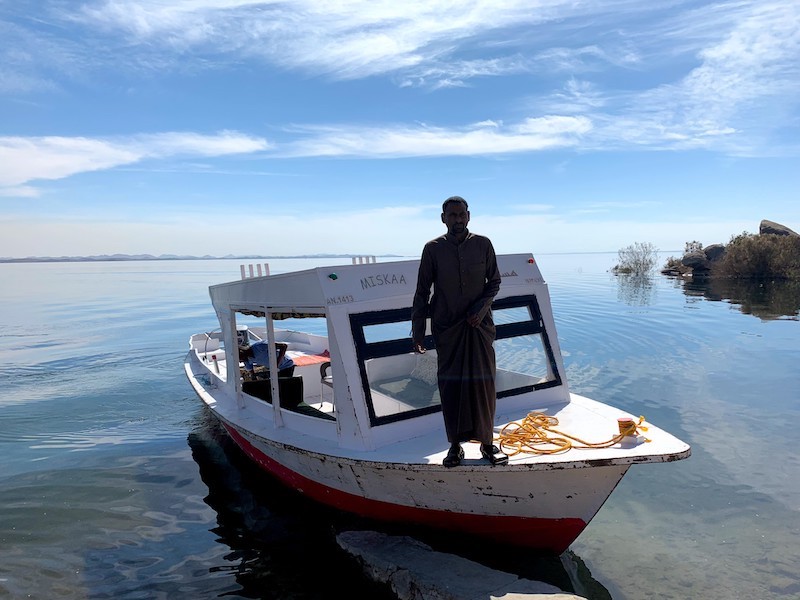
The Kalabsha Temple is also called the Temple of Mandulis after a Nubian god of the sun called Mandulis to whom the temple was dedicated.
The temple was built around 30 BC during the reign of Roman Emperor Augustus over the sanctuary of Amenhotep II. Later with the rise of Christianity, the temple was converted into a Christian church.
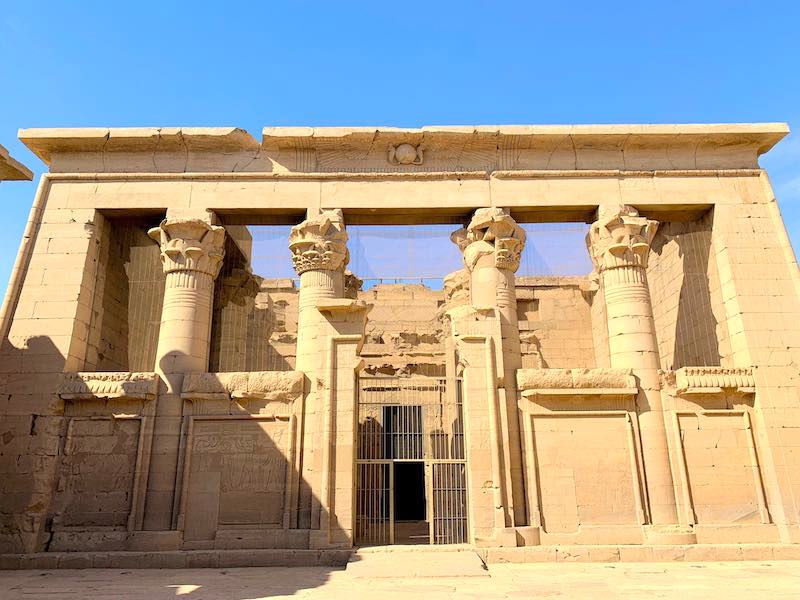
The Kalabsha Temple is the largest freestanding temple in Egyptian Nubia. Beautiful reliefs depicting Horus, Roman Emperor Augusts, falcons, Coptic graffiti … and even some crosses from the Christian era adorn this Egyptian temple.
There are some awe-inspiring structures next to the Temple of Kalabsha: Temple of Gerf Hussein (dedicated to Ramesses II), Temple of Beit el-Wali (dedicated to Amun-Re, Re-Horakhti, Khnum, and Anuket and decorated with beautiful colorful paintings), and Kiosk of Qertassi(a beautiful and elegant Roman kiosk with 6 columns).
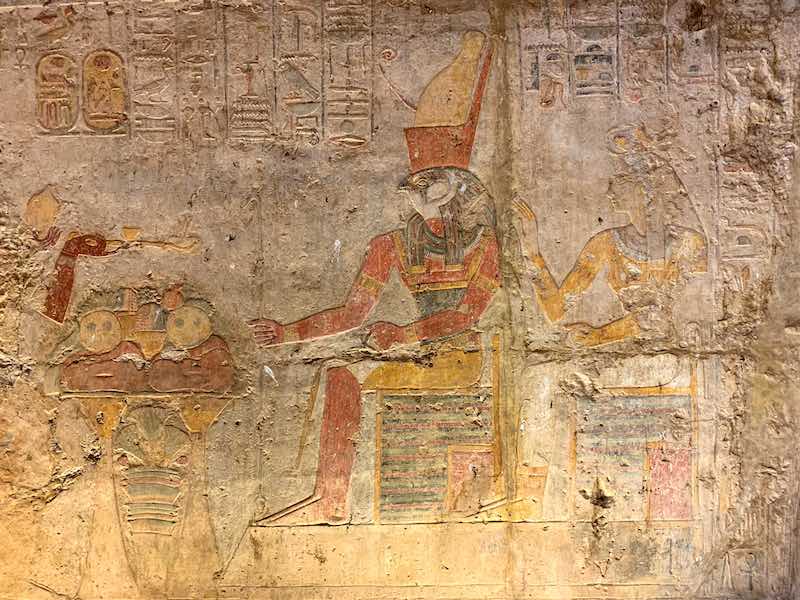
The Kalabsha temple once stood at the site called Bab al-Kalabsha (or the Gate of Kalabsha) in Nubia near Aswan. The temple was relocated to today’s site because of the flooding from Lake Nasser.
Ticket for Kalabsha temple: 150 EGP (2,95 USD) adult, 75 EGP (1,48 USD ) student
Opening times: 7 am – 4 pm
Where is Kalabsha temple?
Kalabsha temple is on an islet next to Aswan High Dam.
How to visit the Kalabsha temple?
Hire a taxi in Aswan (you will need to give a small change for a short boat ride), take a guided tour from Aswan, or join a Lake Nasser cruise (it is the first stop of any Lake Nasser cruise) and visit Kalabsha temple.
10. Temple of Isis (Temple of Philae)
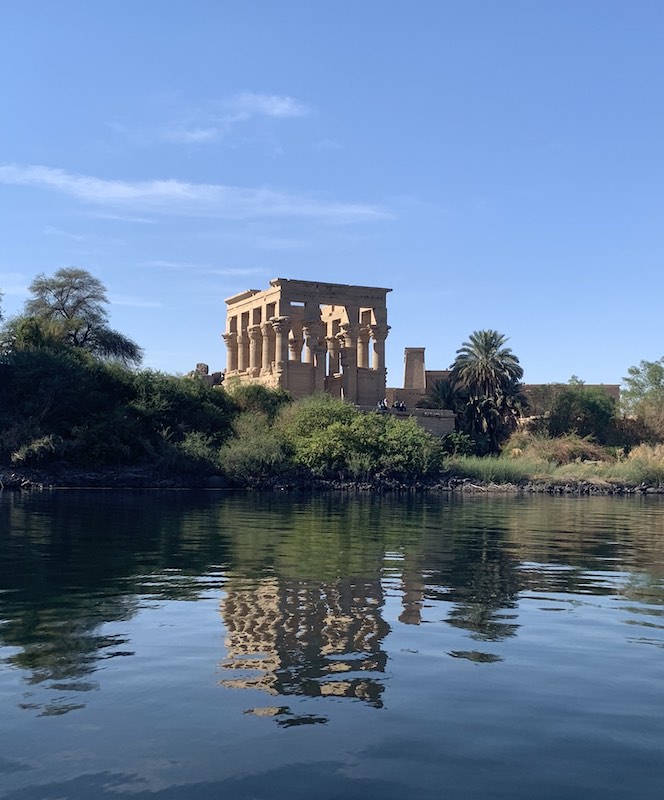
The Isis Temple is an elegant Egyptian temple on the Agilkai island near Aswan. As such, it is one of the most magical places to visit in Egypt.
The Temple of Isis originally stood on the island of Philae in Lake Nasser. That’s why the Isis Temple is commonly known as the Philae Temple. In the 1970s UNESCO relocated the temple from the island of Philae to the nearby island of Agilkai to preserve it from flooding. The Temple of Isis is one of the most beautiful Egyptian temples. It was built in a beautiful classical Egyptian style and the surrounding lake landscape seems unreal. Yes, this is one of the must-visit places in Egypt! The cult of Isis was worshiped in the temple from the 7th century BC until the 6th century AD.
Isis was the Goddess of Motherhood and Fertility and the Divine Mother. She was the sister and wife to Osiris (the god of Life, Death, Afterlife), the mother to Horus (the falcon-headed god of the Sky), and sister to Seth (the god of Evil, Suffering, Pain, Destruction, Thunder, and Desert).
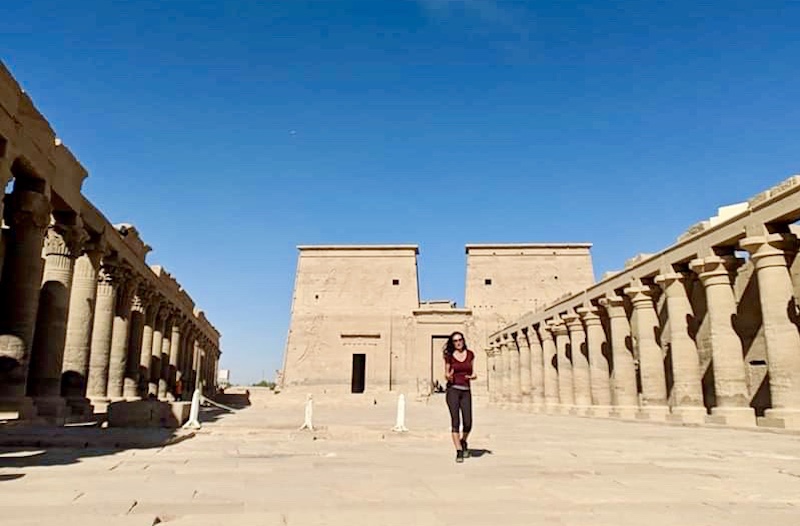
Entrance fee to the Philae Temple: 450 EGP(8,86 USD) adult, 230 EGP (4,53 USD) student
Opening times: 7 am – 4 pm
You need to take a short boat ride from the coast to the island to reach the temple. The return ticket is 150 EGP per boat (150 EGP is divided by the number of people in the boat). Please beware of the boat mafia who will hassle you with the price and will not easily let you enter a boat with other people as prices are charged per boat, not per person.
Where is the Philae temple in Egypt?
The Philae temple is on the Agilkai island on Lake Nasser, and near Aswan.
How to get to the Philae temple?
Hire a taxi in Aswan (you will need to give a small change for crossing the lake by boat), or take a tour from Aswan.
11. Temple of Edfu (Horus Temple)
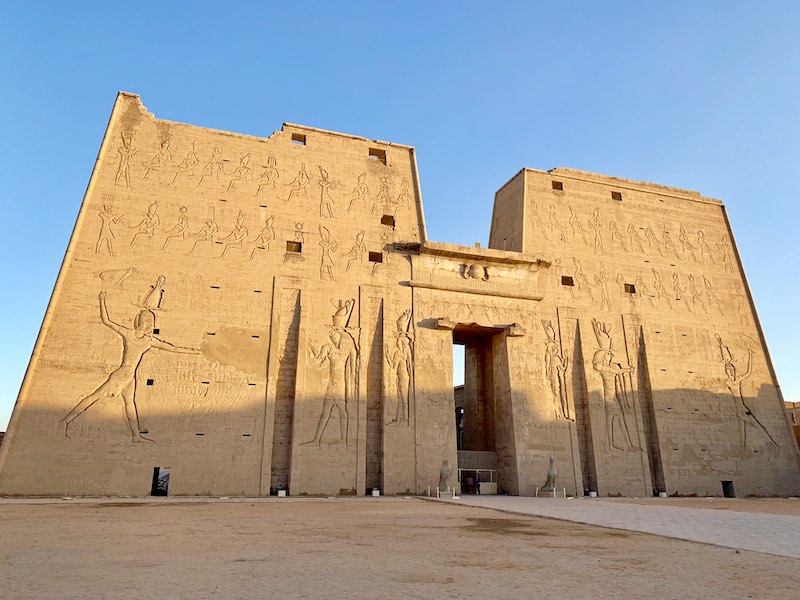
The Temple of Edfu is a famous Egyptian landmark. The city of Edfu is located 110 km south of Luxor and 112 km north of Aswan.
The Temple of Horus in Edfu is the largest temple dedicated to Horus, the falcon-headed god of Sky.
The Edfu Temple was built between the 3rd and the 1st century BC. Although the temple is not as old as other Egyptian temples, the Horus temple is one of the most impressive ancient temples in Egypt. The massive temple consisted of the colossal entrance, forecourt with 32 towering columns, the vestibule (the entrance to the inner temple) with 12 columns, the hall of consecration, hypostyle hall (the place for preparation of rituals), library, alters of the priests and the sanctuary (the room of the gods). The Library of the Edfu Temple was one of the most important and largest libraries of the Ancient World.
Believe me, the Horus Temple at Edfu is one of the most remarkable ancient Egyptian monuments. It’s no secret, that Horus Temple in Edfu was my favorite ancient Egyptian temple. I loved the mystical atmosphere and elegance of the temple. Please, don’t miss adding the Horus Temple in Edfu to your Egypt bucket list!
Horus was the son of Isis and Osiris, and the husband to Hathor, the Egyptian goddess of Love, Music, Beauty, and Happiness (usually pictured with cow horns and a sun disk on her head).
The right eye of Horus represented the Sun and the left eye represented the Moon. The ‘Eye of Horus‘ or so-called Wadjet was a powerful symbol of protection in ancient Egypt.
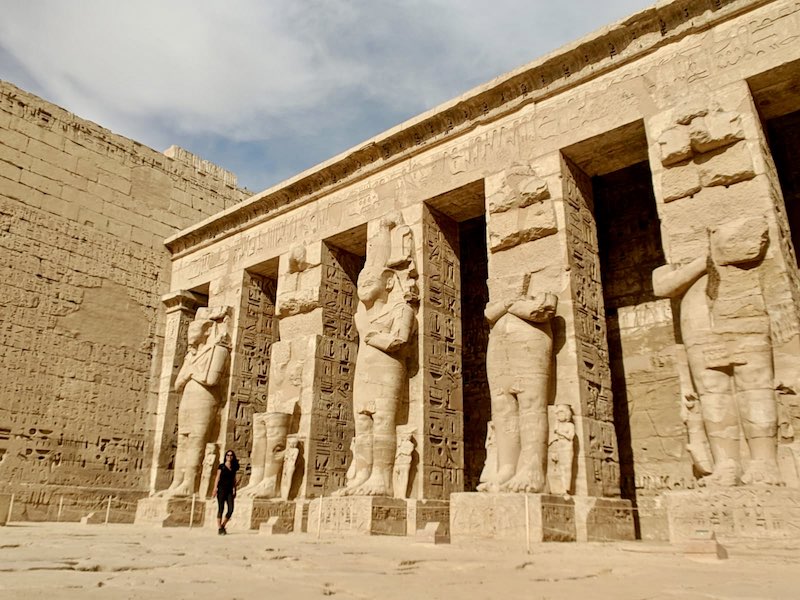
Entrance fee to Edfu Temple: 450 EGP (8,86 USD) adult, 230 EGP (4,53 USD) student
Opening times: 7 am – 4 pm
If you come from a Nile cruise, you must take a horse carriage or Tuk-tuk to reach the temple. Beware of the horse mafia who do their best to overcharge the ride and better take a Tuk-tuk.
How to visit Edfu temple:
7-night round trip cruise Luxor-Aswan-Luxor (to see Edfu temples and other amazing ancient temples along the Nile)
5-Day Nile Cruise from Luxor to Aswan (to see Edfu temples and other amazing ancient temples along the Nile)
4-day Nile Cruise from Aswan to Luxor – (with an overnight train from Cairo to Aswan and to see Edfu temples and other amazing ancient temples along the Nile)
Where is the Edfu temple in Egypt?
The Edfu temple is in the city of Edfu, 68 mi (110 km) south of Luxor and 70 mi (112 km) north of Aswan
How to get to the Edfu temple?
Hire a taxi in Luxor (you could visit the temple of Kom Ombo, the temple in Esna, and the temple of Edfu in the same one-day trip from Luxor ), by 1-hour train ride from Luxor, 1-hour and a half train ride from Aswan, by an Aswan-Luxor cruise ship (like I did), or on a felucca sailing trip from Aswan.
12. Temple of Kom Ombo (Sobek Temple)
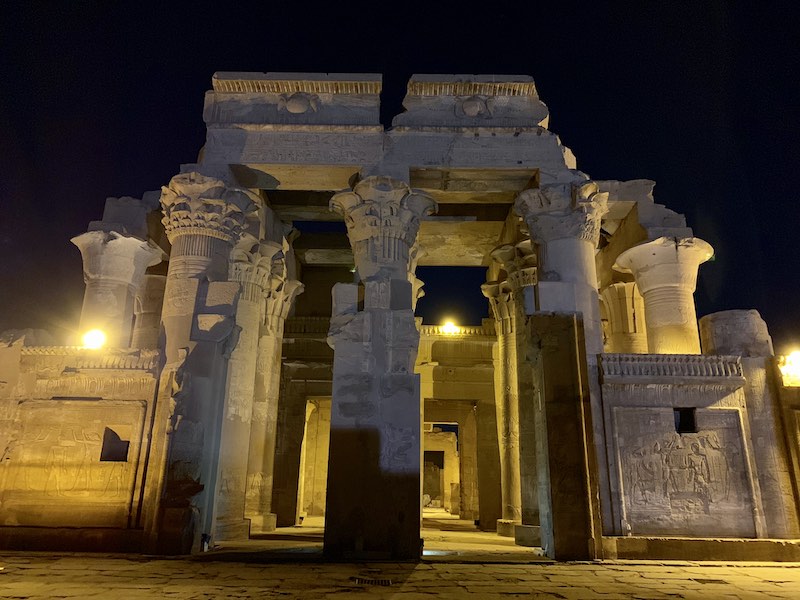
No list of famous landmarks in Egypt is complete without the Kom Ombo temple.
The temple of Kom Ombo is an unusual Egyptian temple since it was dedicated to two gods.
It was dedicated to two rival ancient Egyptian gods: Sobek, the crocodile-headed god, and Horus, the falcon-headed god. Sobek was the god of the Nile and a god of Fertility and Rebirth, while Horus was the god of the Sky.
The temple of Kom Ombo is a perfectly symmetrical temple with twin entrances, two hypostyle halls, twin chambers, and twin sanctuaries. The eastern part of the temple was dedicated to Sobek and the western part was dedicated to Horus.
Entrance fee to the Kom-Ombo Temple & Crocodile Museum: 360 EGP (7,069 USD) adult, 180 EGP (3,54 USD) student
Opening times: 7 am – 4 pm
Visiting Kom-Ombo Temple:
7-night round trip cruise Luxor-Aswan-Luxor (to see Kom-Ombo temple and other amazing ancient temples along the Nile)
5-Day Nile Cruise from Luxor to Aswan (to see Kom-Ombo temple and other amazing ancient temples along the Nile)
4-day Nile Cruise from Aswan to Luxor – (with an overnight train from Cairo to Aswan and to see Kom-Ombo temple and other amazing ancient temples along the Nile)
Where is the temple of Kom Ombo in Egypt?
The Kom Ombo temple is located 28 mi (45 km) north of Aswan, 40 mi (65 km) south of Edfu, and 105 mi (168 km) south of Luxor.
How to get to the temple of Kom Ombo?
By an Aswan-Luxor Nile cruise, by an Aswan-Luxor train, by a two-day felucca sail trip from Aswan, or by hiring a taxi in Luxor or Aswan (visit the temple of Kom Ombo, the temple of Esna, the temple of Edfu on a same day-trip from Aswan or Luxor).
13. KARNAK TEMPLE
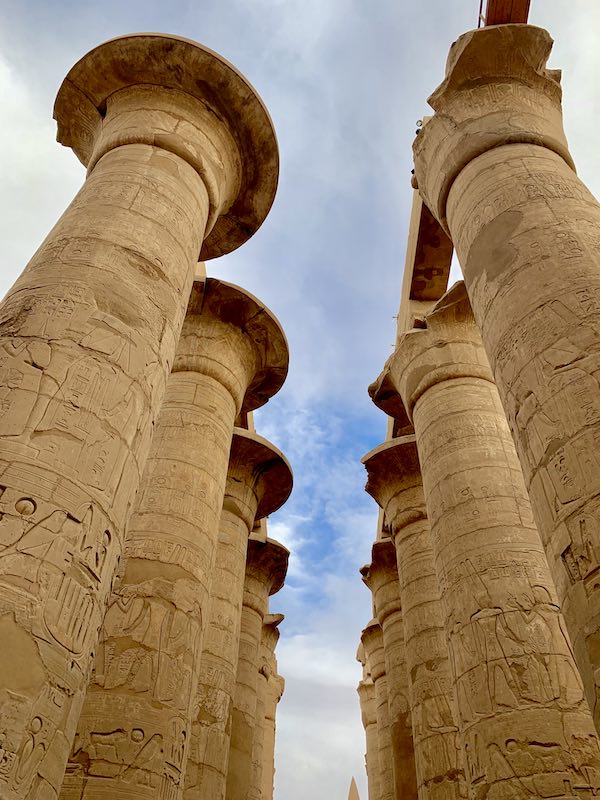
One of the most captivating ancient Egyptian landmarks is the mind-blowing Karnak temple.
The Karnak temple, or the Temple of Amun, is the largest religious ancient site in the World. This amazing temple was built between the 3rd century BC and the 1st century AD. The Karnak Temple is one of the largest temples in the World overall covering more than 247 acres (100 hectares).
Please allow me a small digression and add that Angkor Wat in Cambodia is the largest religious site in the World covering 402 acres (162 hectares). So, please note once again: Angkor Wat is the largest religious site in the World and the Karnak temple is the largest religious site of the Ancient World.
One of the most impressive parts of the temple is the Hypostyle Hall with 123 gigantic columns in 16 rows and the 3 km long sphinxes avenue which is used to connect the Karnak temple and the Luxor temple. For ages, the Karnak temple has been intriguing to visitors and scholars for the way it was built.
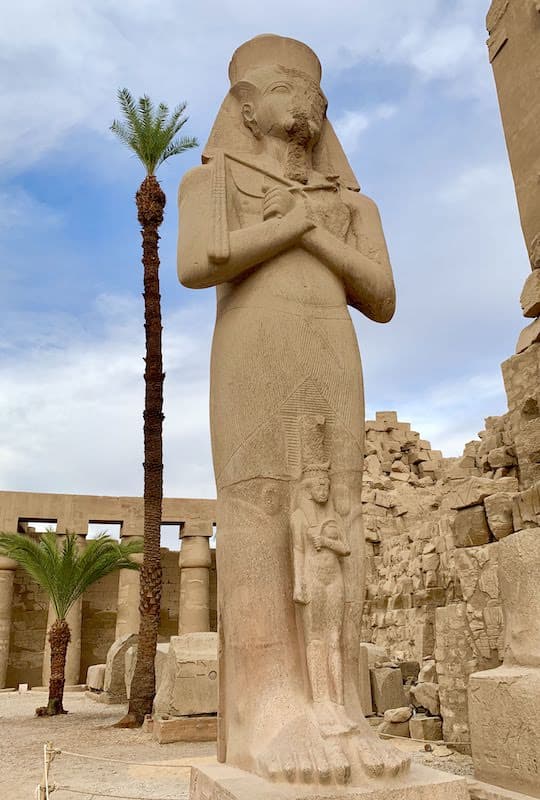
The Karnak Temple complex was built during the reigns of 30 pharaohs, starting around 4,000 years ago and getting completed 2,000 years later.
It was dedicated to the Amun-Ra god, his wife Mut, and their son Khonsu.
Amun-Ra was the supreme Egyptian god and the ‘King of the Gods’ and the ‘God of the Kings’.
His wife Mut was the Mother Goddess, Queen of Goddesses, and the Egyptian goddess of the Sky.
Their son Khonsu (meaning ‘traveler’) was the god of the Moon and the protector of people who travel during the night.
The temple of Karnak is located on the East Bank of the River Nile in Al-Karnak village, near today’s Luxor. Luxor, or ancient Thebes, is one of the most important ancient sites in Egypt and ancient Egyptian cities.
Without any doubt, Karnak Temple and Luxor should be on everyone’s Egypt bucket list as they are one of the most important landmarks of ancient Egypt.
Entrance fee to the Karnak Temple: 450 EGP (8,86 USD) adult, 230 EGP (4,53 USD) student
Opening times: 6 am – 5 pm
Recommended stay in Luxor:
Bob Marley Peace Hotel Luxor, Luxor Guest House, Amon Hotel, Hilton Luxor Resort & Spa
Options how to visit Karnak temple in Luxor:
7-night round trip cruise Luxor-Aswan-Luxor (to see Karnak temple and other amazing ancient temples along the Nile)
5-Day Nile Cruise from Luxor to Aswan (to see Karnak temple and other amazing ancient temples along the Nile)
4-day Nile Cruise from Aswan to Luxor – (with an overnight train from Cairo to Aswan and to see Karnak temple and other amazing ancient temples along the Nile)
Where is the Karnak temple in Egypt?
The temple of Karnak is located on the East Bank of the River Nile in Al-Karnak village, near today’s Luxor. The temples of Karnak and Luxor are 3 mi (5 km) apart.
How to get to the Karnak temple?
Walk from the Luxor downtown to the Karnak temple, hire a taxi, or hire a horse carriage in Luxor.
14. Temple of Habu (Medinet Habu)
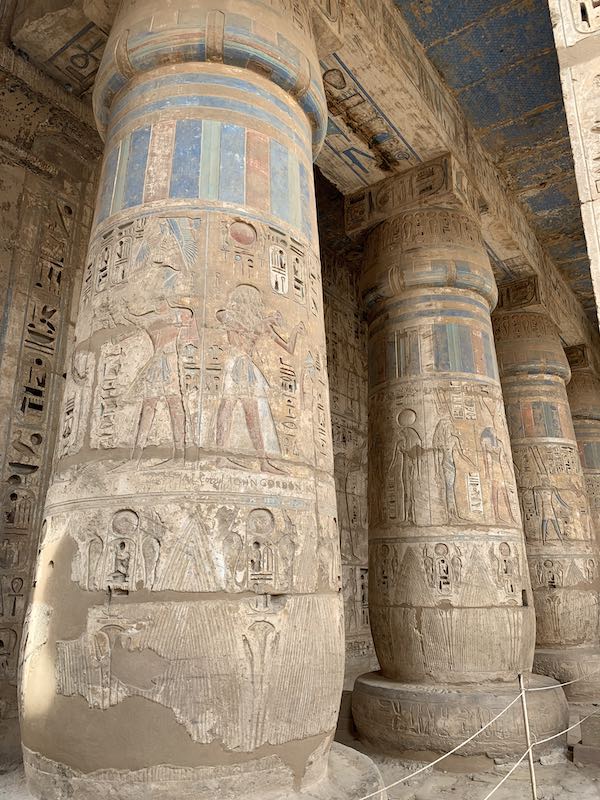
Another famous landmark in Egypt is Medinet Habu.
The Mortuary Temple of Ramesses III or Medinet Habu is located on the west bank of the Nile River, approximately 4 miles (6.5 km) from the Valley of the Kings.
The Medinet Habu adorns one of the most beautiful carvings you will see in Egypt. Plus, the temple’s reliefs are some of the best preserved in Egypt. Because of that, the Madinat Habu Temple is one of the must-see ancient Egyptian landmarks.
Ramesses III was the last great pharaoh of the New Kingdom and his temple dates back to the 12th century BC. Reliefs in the temple picture various religious ritual scenes as well as the war scenes of Pharaoh III against Libyans and Sea People.
Entrance fee to the Habu Temple: 200 EGP (3,94 USD) adult, 100 EGP (1,97 USD) student
Opening hours: 6 am – 5 pm
Options for how to visit Habu Temple:
7-night round trip cruise Luxor-Aswan-Luxor (to see Habu temple and other amazing ancient temples along the Nile)
5-Day Nile Cruise from Luxor to Aswan (to see Habu temple and other amazing ancient temples along the Nile)
4-day Nile Cruise from Aswan to Luxor – (with an overnight train from Cairo to Aswan and to see Habu temple and other amazing ancient temples along the Nile)
Where is the Medinet Habu in Egypt?
The Medinet Habu is located on the West Bank of the River Nile, on the outskirts of Luxor. The temple of Karnak and the Luxor downtown are 3 mi (5 km) apart.
How to get to Medinet Habu?
Hire a taxi in Luxor, or join a tour in Luxor.
15. Valley of the Kings
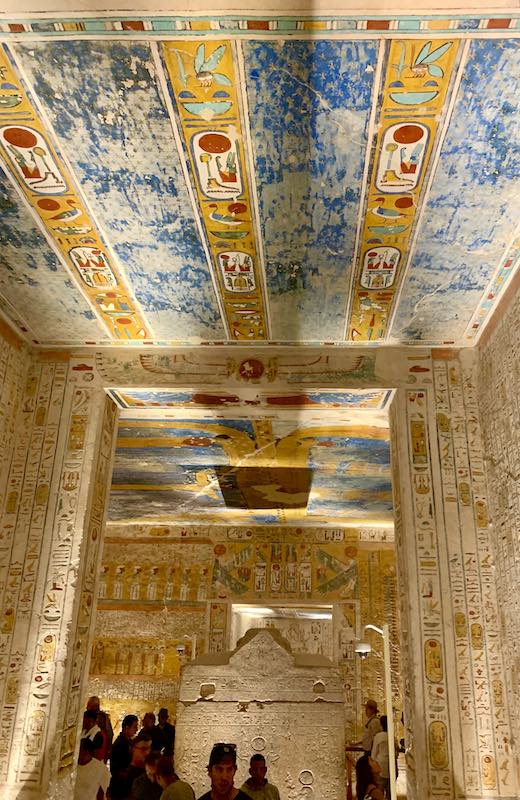
The Valley of the Gate of the Kings is the burial site of Egyptian Kings on the West Bank of the Nile River near Luxor and without doubt one of the most famous landmarks of Egypt.
Called the Gateway to the Afterlife, the Valley of the Kings holds 60 pharaonic tombs built between 1.500 and 1.000 BC.
Let’s just say that the most famous Egyptian pharaohs like Tutankhamun, Seti I, and Ramesses II were buried in the tombs in the Valley of the Kings, not in pyramids. In other words, you will find the most famous Egyptian tombs in the Valley of the Kings.
Thus, the Valley of the Tombs of the Kings is one of the top Egypt tourist attractions.
If you want to visit the most beautiful and largest cemetery in the Ancient World, don’t miss out on Valley of the Kings.
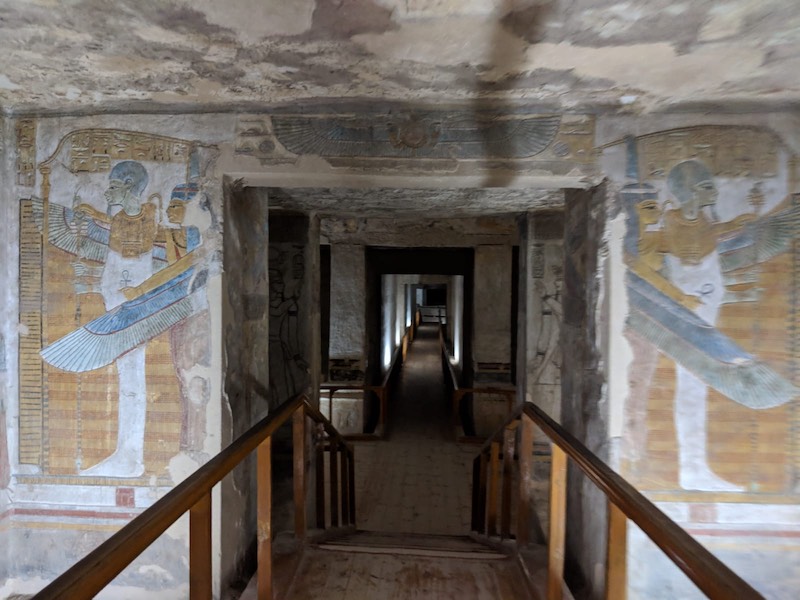
Entrance fee to the Valley of the Kings (includes visiting up to 3 tombs): 600 EGP (11,81 USD) adult, 300 EGP (5,91 USD) student
Opening times: 6 am – 5 pm
Where is the Valley of the Kings located?
The Valley of Kings is on the west bank of the Nile River, near the city of Luxor. The Valley of the Kings is 18 mi (29 km) from Luxor.
How to get to the Valley of Kings?
Hire a taxi in Luxor(it is a 45-minute drive), or join a tour in Luxor.
16. Mortuary temple of Hatshepsut
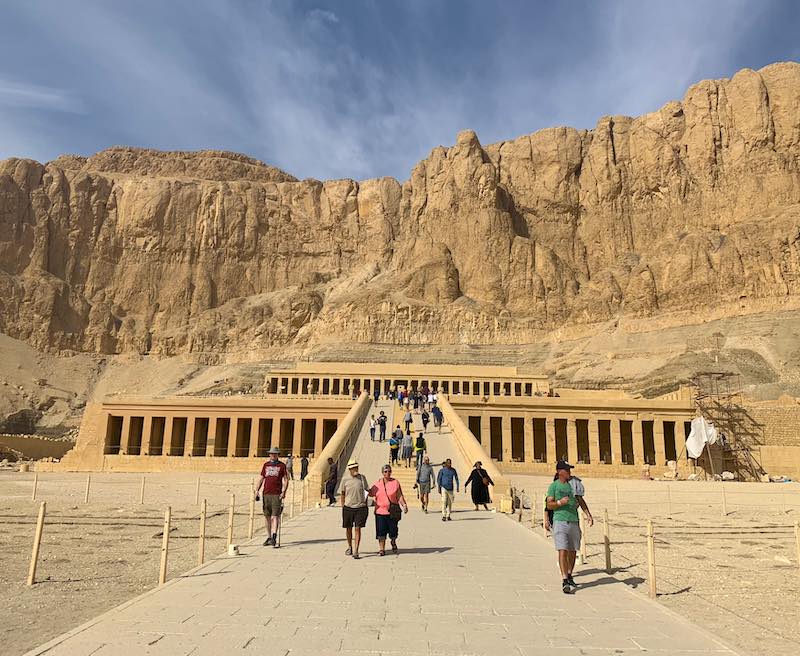
One of the most impressive landmarks in Egypt is the temple of Hatshepsut on the west bank of the Nile River, near the Valley of Kings.
This is the mortuary temple of Queen Hatshepsut, a famous ancient Egyptian queen, and a strong female pharaoh. She broke with the tradition of male pharaohs becoming the first female Egyptian pharaoh. Furthermore, Pharaoh Hatshepsut was one of the most successful pharaohs ruling Egypt for about 21 years and bringing peace and prosperity to Egypt.
As a female pharaoh, Hatshepsut was worshiped as the wife of the god Amun (the ancient Egyptian god of the sun and air).
Today Hatshepsut is widely known as one of the all-time greatest women in history, while her mortuary temple stands as proof of the elegance and grandeur of her reign.
Entrance fee to Mortuary Temple of Hatshepsut: 360 EGP (7,09 USD) adult, 180 EGP (3,54 USD) student
Opening hours: 6 am – 5 pm
Options for how to visit the Temple of Hatshepsut:
7-night round trip cruise Luxor-Aswan-Luxor (to see the temple of Hatshepsut and other amazing ancient temples along the Nile)
5-Day Nile Cruise from Luxor to Aswan (to see the temple of Hatshepsut and other amazing ancient temples along the Nile)
4-day Nile Cruise from Aswan to Luxor – (with an overnight train from Cairo to Aswan and to see the temple of Hatshepsut and other amazing ancient temples along the Nile)
Where is the mortuary temple of Hatshepsut?
The mortuary temple of Hatshepsut is on the west bank of the Nile River, near the city of Luxor. The mortuary temple of Hatshepsut is 17 mi (28 km) from Luxor.
How to get to the mortuary temple of Hatshepsut?
Hire a taxi in Luxor, or join a tour in Luxor (ask your hotel in Luxor about the tour).
17. Colossi of Memnon
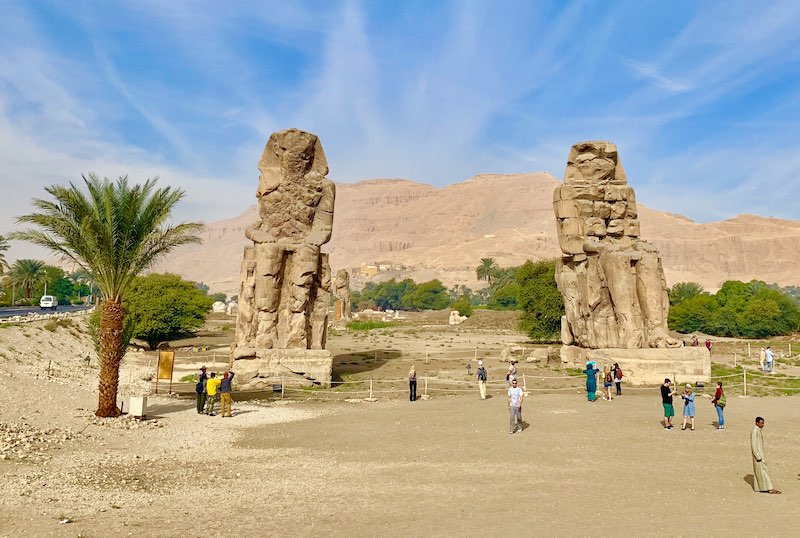
The statues of Memnon were guardians of Amenhotep III’s mortuary complex.
The mortuary complex represented the Field of Reeds – the Egyptian paradise. Each statue was made of a single sandstone block and is 60 ft (18 m) high and weighing 720 t. The complex covered around 86 acres (35 hectares) and is believed to be more impressive than the Temple of Karnak at that time.
Memnon was an Ethiopian King and a hero of the Trojan War who fought against the Greeks and got killed by Achilles. The statues actually represent the ancient Egyptian New Kingdom’s Pharaoh Amenhotep III who lived and ruled around 1350 BC. But in the 3rd century BC, Greek Egyptologist Manetho believed that Amenhotep and Memnon were actually one person. Since then these Egyptian statues are known to the World as the Colossi of Memnon.
The 3.400-year-old statutes of Memnon are located on the West bank of the Nile River near Luxor.
Entrance to the Colossi of Memnon: free
Opening hours: 6 am – 5 pm
Where are the colossi of Memnon?
The colossi of Memnon is on the west bank of the Nile River, near the city of Luxor. The mortuary temple of Hatshepsut is 15 mi (24km) from Luxor.
How to get to the colossi of Memnon?
Hire a taxi in Luxor, or join a tour in Luxor (you can visit the colossi of Memnon, the temple of Hatshepsut, and the Valley of the Kings on the same-day tour)
18. Alexandria library
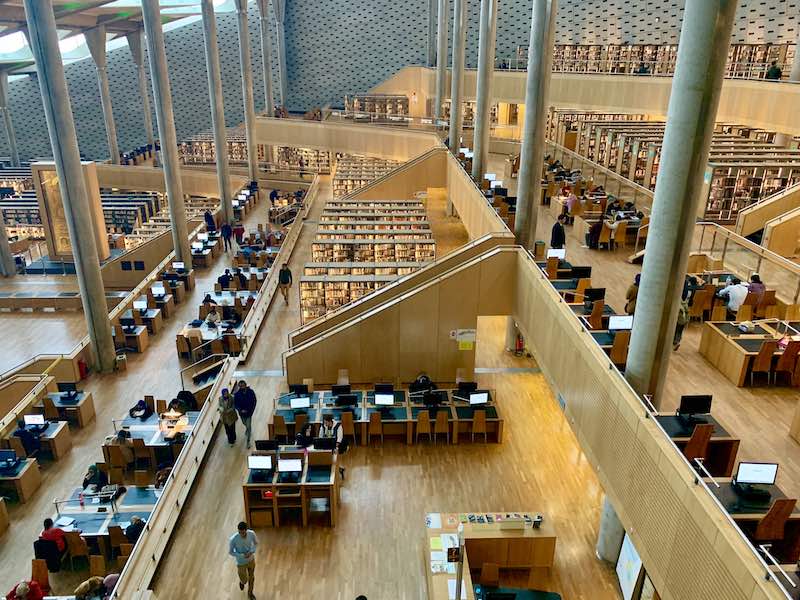
Alexandria is one of the top historically important places in Egypt.
Alexandria was founded by, and named after, one of the most famous soldiers and heroes in history ever – Alexander the Great. Alexandria is one of the most important places in Egypt. Three powerful ancient cultures were united – the Egyptian, Greek (from the 4th century BC), and Roman (the 1st century BC) in Alexandria in ancient times.
The Great Library of Alexandria operated from the 4th century BC until the 3rd century AD as the largest library in the World holding about 400,000 – 700,000 parchment scrolls, while at that time Alexandria was the capital of knowledge and learning in the Ancient World. There are many legends and hypotheses, but no one exactly knows what happened with the ancient Library of Alexandria – maybe it burnt, maybe it was destroyed during some historical turmoil or simply declined over time. The destruction or fading of the ancient Library of Alexandria remains one of the mysteries of Ancient Egypt.
The new Bibliotheca Alexandrina was inaugurated in 2002 as a grand rebirth of the ancient library. The library holds the main library, 6 specialized libraries, the Internet Archive, several exhibition areas, 4 museums, the CULTURAMA Hall, and a digital library. While the library has the potential of hosting 8.000.000 books, so far the books have been donated to the Alexandria library from all over the World. The reading area of the main library is spread on 11 levels covering 5 acres (2 hectares) in total. The architecture of the modern library is surprisingly spectacular as was the ancient one.
The Bibliotheca Alexandrina is another famous landmark of Egypt, an unbeatable unique place to see in Egypt, and a compulsory stop for all bookworms on their trip to Egypt.
Visiting Alexandria: Alexandria Day Tour with a Local Guide
Entrance fee to the Bibliotheca Alexandrina: 150 EGP (2,95 USD) adult, 20 EGP (0,39 USD) student
Opening hours of the Bibliotheca Alexandrina for visitors: 10 am – 7 pm Sun-Thu, 2 pm- 7 pm Fri, 12 pm – 4 pm Sun
Recommended stay in Alexandria:
Paradise Inn Beach Resort, Steigenberger Cecil Alexandria, Hilton Alexandria Corniche, Four Seasons Hotel Alexandria at San Stefano
19. Catacombs of Kom El Shoqafa
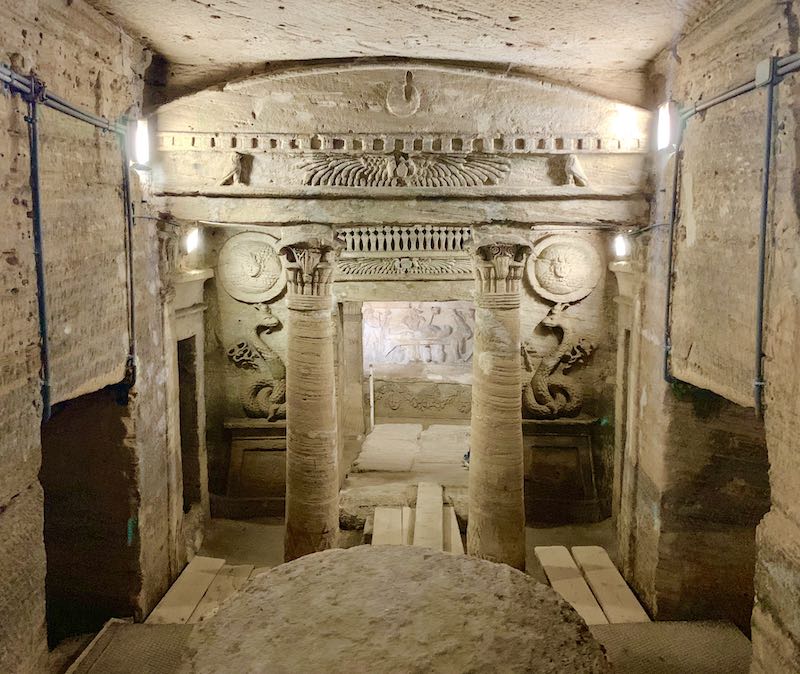
The Kom al-Shoqafa catacombs in Alexandria are a UNESCO World Heritage site in Egypt and therefore one of the best places to visit in Egypt.
The catacombs were built in the 2nd century AD and were a burial place for the next 200 years. Marvelous catacombs’ carvings demonstrate a unique mix of 3 powerful ancient cultures – the Egyptian, Greek, and Roman. A visitor can witness a remarkable fusion of 3 ancient artistic styles – the old Egyptian and Greco-Roman in the Kom al-Shoqafa necropolis. This is where the visitor can see Anubis (the Egyptian god of embalming and the dead) dressed as a Roman legionary with a serpent tail of Agathos (the Greco-Roman god of Fortune)!
The catacombs of the Kom al-Shoqafa in Alexandria are an exceptional Egypt landmark and one of the Seven Wonders of the Medieval World together with Stonehenge, the Colosseum, the Great Wall of China, the Porcelain Tower of Nanjing, Hagia Sophia, the Leaning Tower of Pisa, and Taj Mahal.
How to visit Kom al-Shoqafa catacombs:
One-Day Tour of Historical Alexandria from Cairo
Archeological Day Trip to Alexandria from Cairo
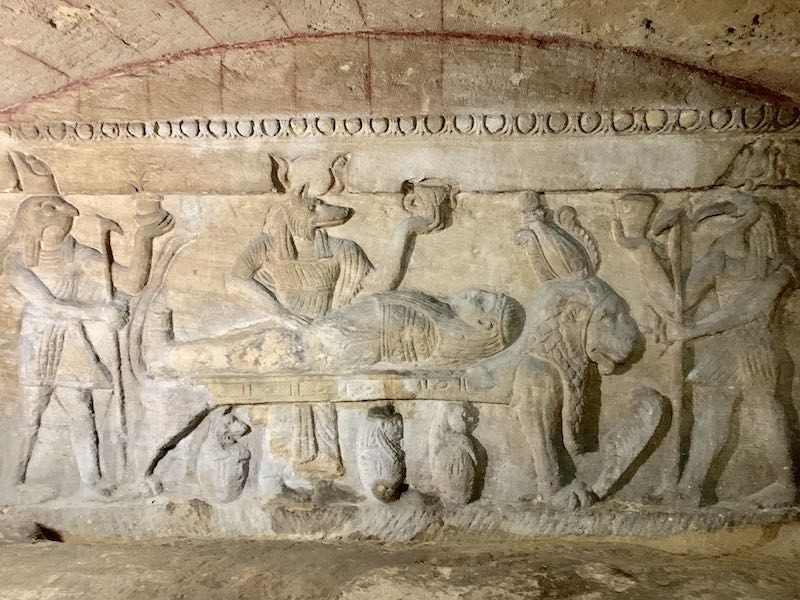
Entrance fee to the Kom al-Shoqafa: 150 EGP (2,95 USD) adult, 75 EGP (1,48 USD) student
Opening times of Catcambos in Alexandria: 9 am – 5 pm
20. Nile River with felucca sail on the Nile River and Nile River Cruise
Sailing the mighty Nile River is a must in Egypt. No one wants to miss an opportunity to sail the longest river in the World and one of the most beautiful rivers in the World, right?!
Sailing the Nile is the best way to see all the ancient Egyptian temples along the Nile and at the same time enjoy the tranquility, bliss, and magic of the mesmerizing Nile.
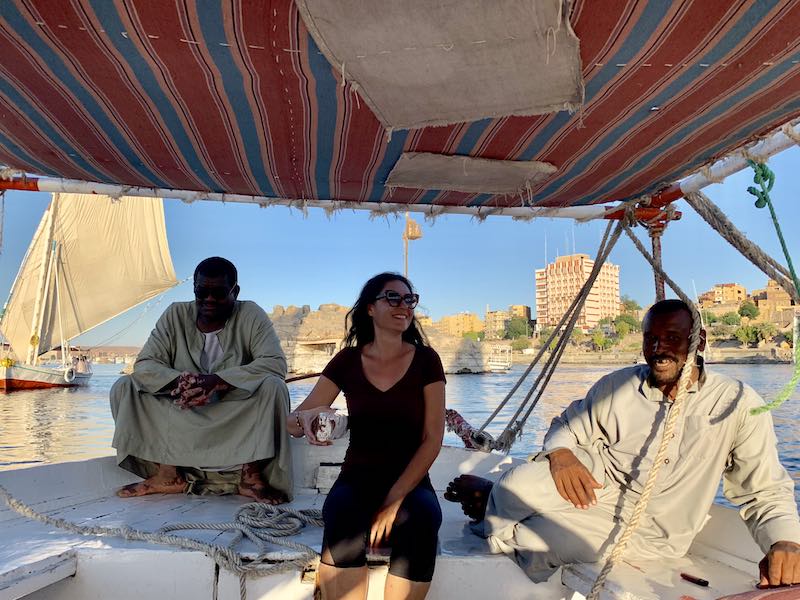
The most popular sailing routes down the Nile in Egypt go from Aswan to Luxor, and from Luxor to Aswan, or round trip cruise Luxor-Aswan-Luxor.
If you are a nature lover then you should opt for a sail on a wind-powered traditional Egyptian sailboat called ‘felucca’. Feluccas can take up to 12 people.
If you are spending your holidays in Egypt with your partner, then be sure that the felucca ride will grant you many romantic moments on the Nile.
If you are traveling to Egypt with your kids or seeking more comfort on your Egypt trip, take a Nile river cruise.
The Nile sails are one of the flagships of Egypt tourism and as such unmissable things to do in Egypt. I took 4 day Nile cruise from Aswan to Luxor and a felucca ride in the Aswan area. There are no words to describe the beauty of cruising the Nile River. And as much as I enjoyed the cruise, I am dreaming of coming back to Egypt and sailing on a felucca again! Don’t forget to add sailing the Nile to your Egypt bucket list!
Options for sailing the Nile:
Felucca Ride on the Nile in Aswan
5-Day Nile Cruise from Luxor to Aswan (and to see all the above-mentioned temples along the Nile)
4-day Nile Cruise from Aswan to Luxor – with an overnight train from Cairo to Aswan (and see all the above-mentioned temples along the Nile)
Felucca Ride on the Nile in Cairo – if you are visiting Cairo and want to experience a felucca ride in Cairo
21. Nubian village
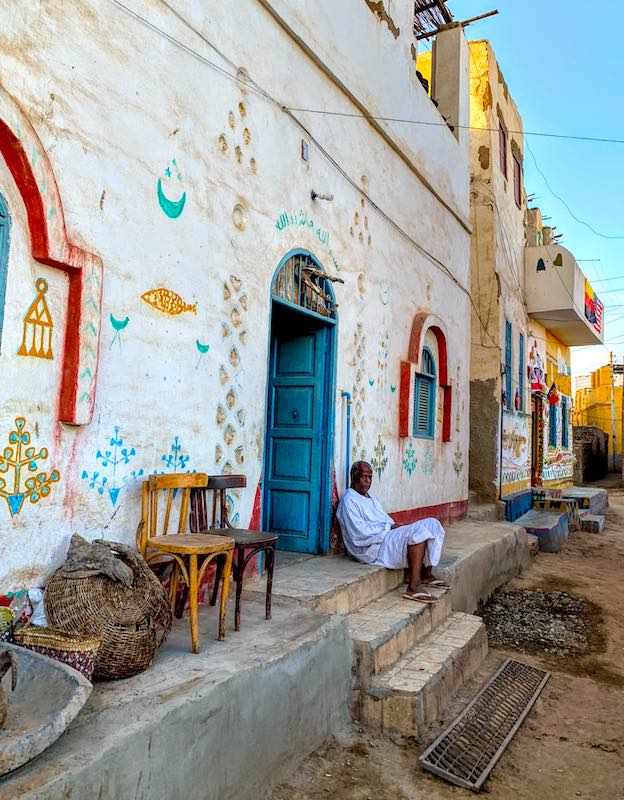
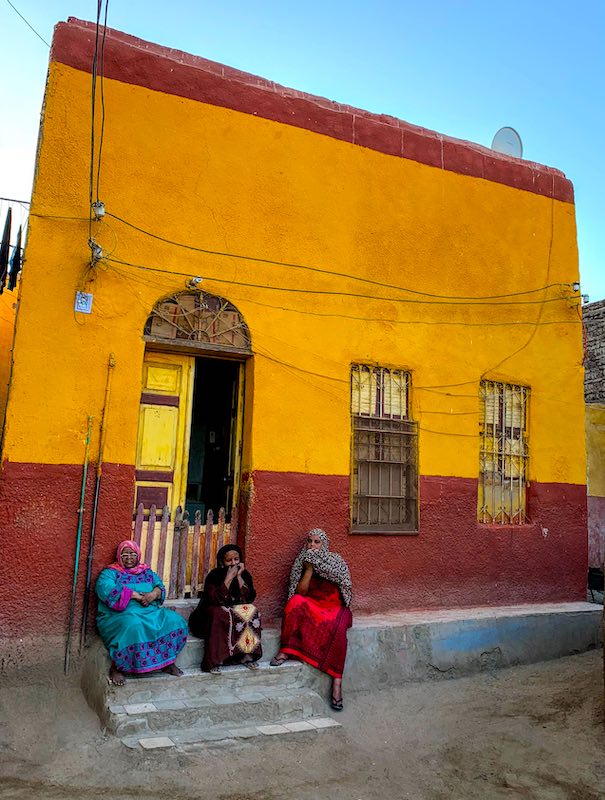
It might seem odd to have Nubian village on the list of Egypt landmarks at first sight, but in case you don’t know Nubians are one of the oldest civilizations in history.
Nubian people have settled along the Nile River in the south of Egypt and the north of Sudan and today you can find them in a village near Aswan in Egypt.
For thousands of years, Nubians have preserved their Nubian language which is solely spoken language with no alphabet. Old Nubian texts were written using a version of the Coptic alphabet. though. Instead of the alphabet, Nubians use descriptive pictures.
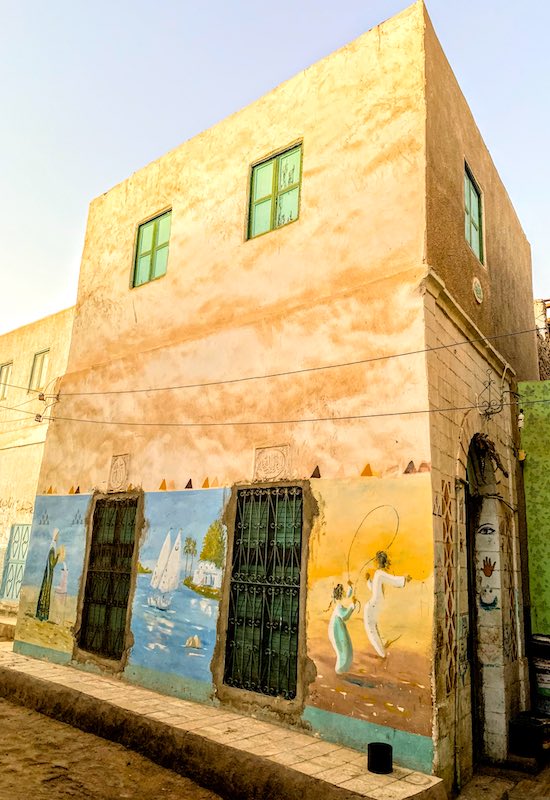
An interesting fact is that Egyptians employed Nubian-speaking Nubians as code talkers during the Arab-Israeli war in 1973.
But no matter what, Nubians have been keeping their interesting tradition and amazing art well-known for bright and vivid colors and geometric shapes for thousands of years.
Take a felucca ride in Aswan as I did, cross the Nile, visit colorful Nubian villages, and enjoy the hospitality of kind Nubians in Egypt. Remember, not every day you do have an opportunity to visit one of the earliest cradles of civilization!
22. Mount Sinai
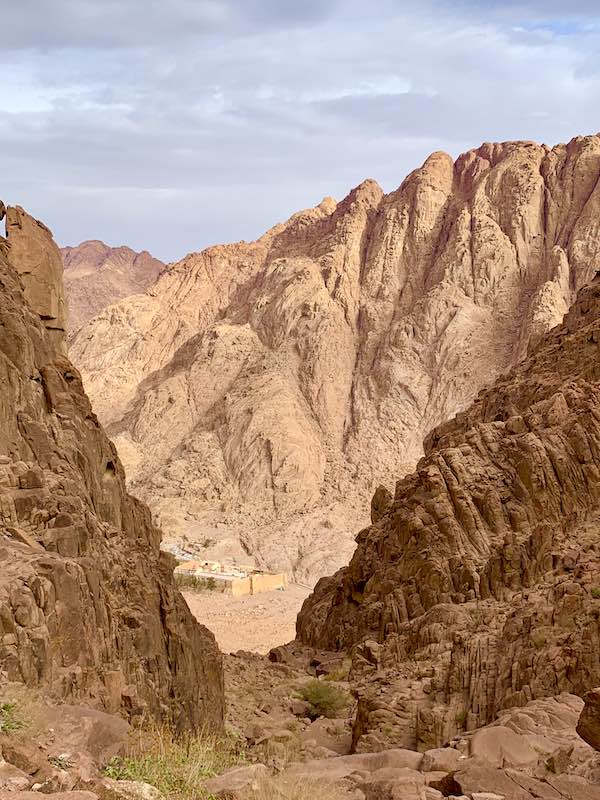
Mount Sinai is popularly known as the Moses Mountain.
Mount Sinai is one of the famous places in Egypt not related to Ancient Egypt but to the Bible, the Book of Exodus, and the Quran.
Mount Sinai is believed to be the biblical Mount Sinai where Moses received the Ten Commandments.
Mt Sinai is one of the natural attractions in Egypt for its striking landscapes and one of the most popular places in Egypt for hiking. Popular hikes go from the St Catherine monastery to the top of Mt Sinai where Moses is believed to receive the Ten Commandments (the Tablets of the Law). The breathtaking scenery of Mt Sinai awards the climbers along the way to the peak of Mt Sinai. The most popular hikes go for sunset and sunrise and take 2-3 hours from the St Catherine monastery which stands at the foot of Mt Sinai to the top of Moses’ Mountain.
No matter if you are spiritual, religious, a nature lover, or a mountain climber, hiking Moses’ Mountain should not be skipped on your Egypt itinerary.
23. Monastery of St Catherine
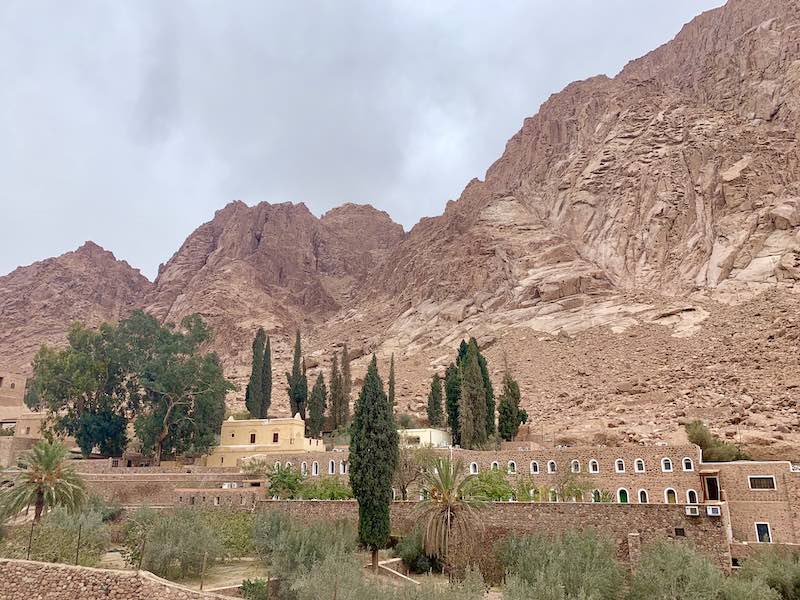
The St Catherine monastery in Sinai is one of the oldest monasteries in the World dating from the 6th century AD and a UNESCO World Heritage Site in Egypt.
This Greek Orthodox monastery in the Sinai peninsula holds the most sacred bush in the World – the biblical Burning Bush from which God had spoken to Moses. Here you can also find the Moses Well where Biblical Moses is believed to have met his future wife Zipporah for the first time. The site is important to all 3 Abrahamic faiths and is a holy site of Judaism, Christianity, and Islam.
The Sinai monastery also runs the oldest continually running library in the World which is also the second-largest Christian library in the World, after the Vatican Library in Rome.
Options for visiting Mt Sinai and St Catherine monastery:
St. Catherine’s Monastery and Dahab from Sharm-El Sheikh (tour from Sharm-El Sheikh)
Mount Moses Trekking, Sunrise & Monastery Visit from Sharm-El Sheikh ( tour from Sharm-El Sheikh)
Entrance fee to the National Park of Egypt Saint Katherine Protectorate: 200 EGP (4 USD)
Daily bus tours are organized from Dahab and Sharm El-Sheikh to Mount Sinai and St Catherine Monastery.
24. Al Azahar Mosque in Cairo
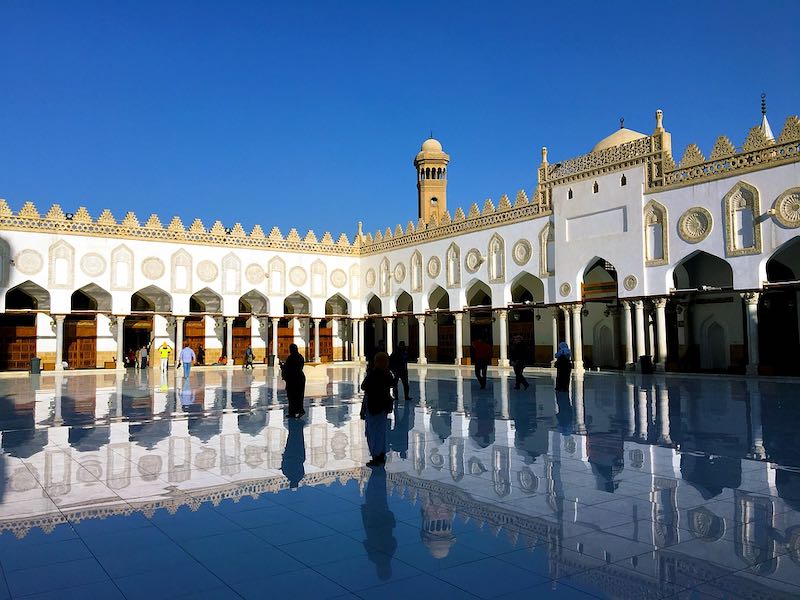
Cairo is nicknamed ‘The City of a Thousand Minarets‘, and the first mosque built in Cairo is Al-Azhar Mosque.
The mosque was built in 970 during the Fatimid Caliphate. Al-Azhar Mosque holds also Al-Azhar University which is the second oldest continuously run Islamic university in the world (after Al-Karaouine University in Fez in Marocco). The mosque and university follow a long tradition of Sunni Islam, although they were built in the Shia Islam tradition of the Fatimid Caliphate.
Al-Azhar Mosque is an important landmark of Cairo and a landmark of Egypt.
25. Cairo Citadel
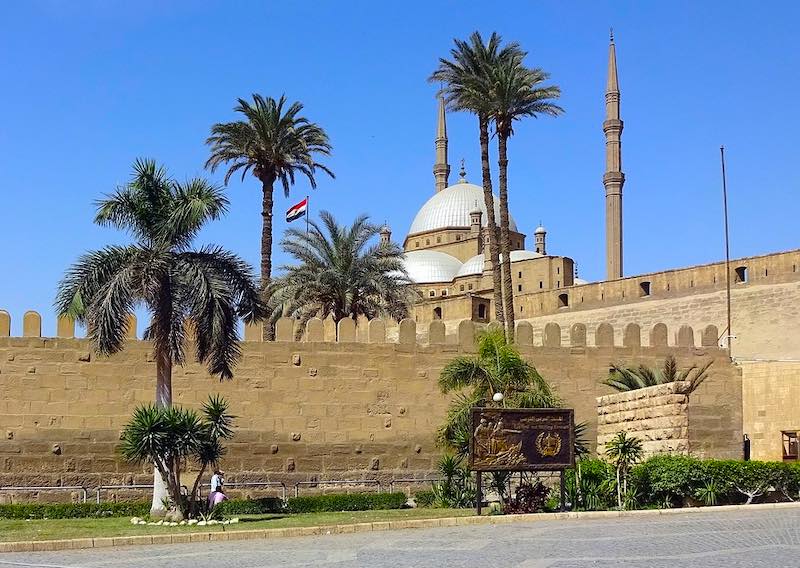
Cairo Citadel on the Mukattam Hills is a famous landmark of Egypt.
Salah al-Din al-Ayyubi Citadel was built in the 12 century by the famous Saladin, one of the most famous sultans and Muslim heroes in history ever. Later constructions were made during the Mamluk period, Ottoman period, and Muhammad Ali period.
The citadel was the residence of Egyptian rulers and the seat of the Egyptian government for 700 years. Cairo citadel served as the seat of the Egyptian government for centuries thanks to its great location on the hills which was hard to attack and conquer.
The Citadel is a historical architectural masterpiece that unites military and palatial architecture.
Entrance fee to Salah al-Din al-Ayyubi Citadel: 450 EGP (8,86 USD) adult, 230 EGP (4,53 USD) student
Opening hours: 8 am – 5 pm
26. The Hanging Church in Coptic Cairo
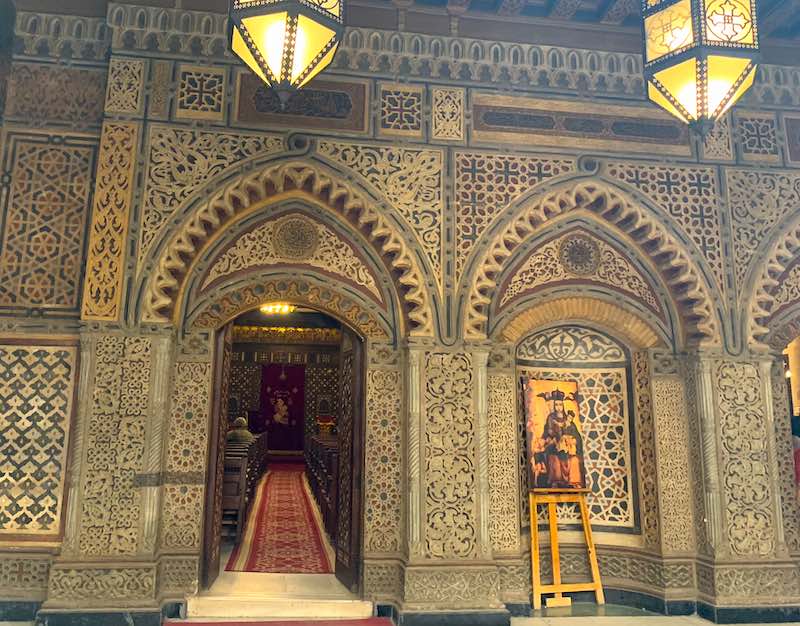
Coptic Cairo is the heart of ancient Egyptian Christianity.
The Hanging Church in Coptic Cairo is the most famous church in Egypt and the official residence of the Coptic Pope.
The official name of the church is Saint Virgin Mary’s Church, but it is widely known as the Hanging Church of Cairo since it was built atop ancient Babylon fortress gates in 690. Therefore the church appeared to be hanging. The church was made from ebony and additionally ornamented with ivory. One of the most prominent features of the church is the ceiling that mimics Noah’s ark. The Hanging Church holds many exquisite Coptic Orthodox icons.
The oldest icon is the famous Coptic Mona Lisa Virgin Mary with Baby Jesus sitting on her lap and John the Baptist standing next to them. The church is connected to several apparitions of the Virgin Mary.
The Hanging Church in Cairo is free to enter.
The church is open from 9 am to 4 pm.
27. Ben Ezra Synagogue in Cairo
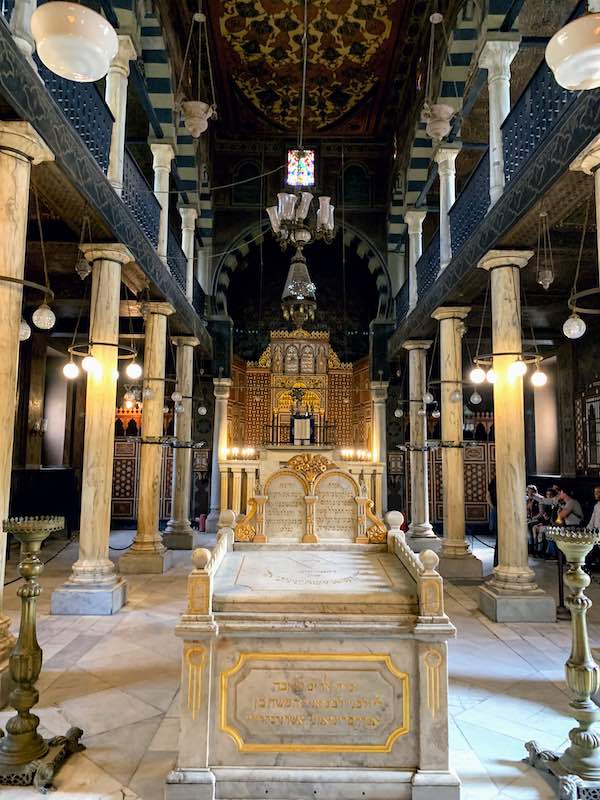
Ben Ezra Synagogue in Cairo is believed to be the place where the basket with the Biblical baby Moses was found.
The Ben Ezra Synagogue was originally a church, but in the 9th century, Coptic Christians sold it to Jews as they needed money to pay the imposed annual tax.
The Ben Ezra Synagogue is just behind the Hanging Church in Coptic Cairo. The synagogue holds a famous medieval storeroom where about 400,000 rare medieval manuscripts (known as Cairo Geniza) written in Hebrew, Arabic, and Aramaic were found. Today the University of Cambridge holds the majority of the Cairo Geniza manuscripts.
Ben Ezra Synagogue in Cairo is free to enter. The synagogue is open from 9 am to 4 pm.
28. Suez Canal
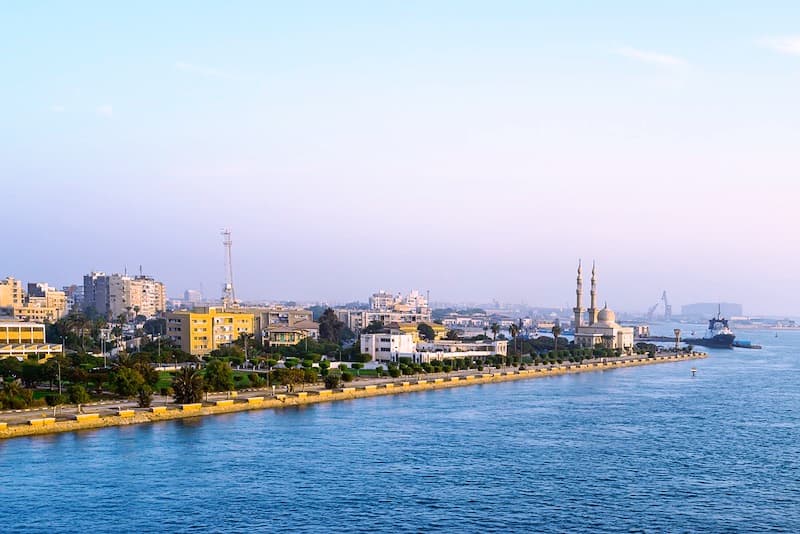
The Suez Canal is one of the most important canals in the world.
It’s an artificial canal connecting the Mediterranean Sea and the Red Sea. Suez Canal officially divides Africa and Asia.
The maritime route from Europe to India and the western Pacific is shortened by opening the canal since the South Atlantic Ocean and South Indian Ocean are skipped on the route. The canal was opened in 1869.
The Suez Canal stretches from the town of Port Said to the town of Suez.
29. Aswan High Dam
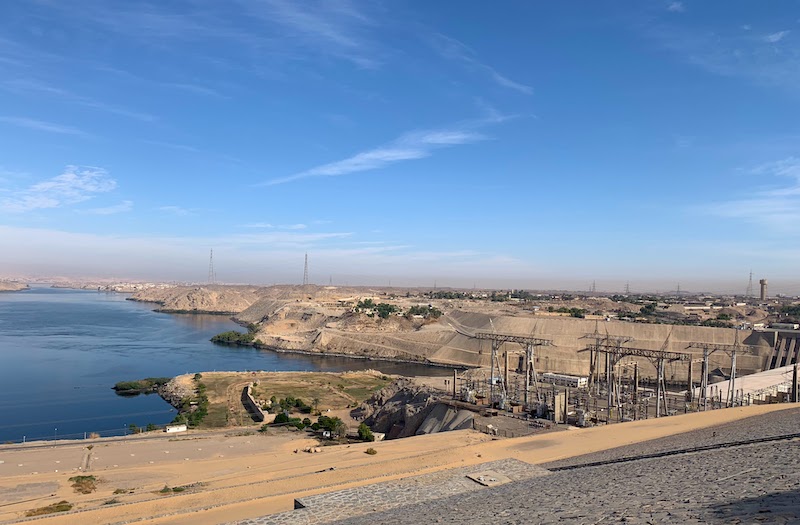
Aswan High Dam is not a picturesque landmark in Egypt, but it’s definitely one of the most famous landmarks in Egypt.
Aswan High Dam is one of the largest dams in the world. It ranks 14th by size on the list of the largest dams in the world.
The High Dam near Aswan on the Nile River forms a water reservoir called Lake Nasser. Lake Nasser is 500 km (310 mi) long and 35 km (22 mi) wide. Aswan High Dam is important since it controls the flooding of the River Nile, irrigates the area when needed, and creates electricity.
An interesting fact is, that the above-mentioned Abu Simbel Temple was relocated for the purpose of building the dam.
Aswan High Dam was opened in 1970. The dam is a short drive away from the town of Aswan.
30. White Desert
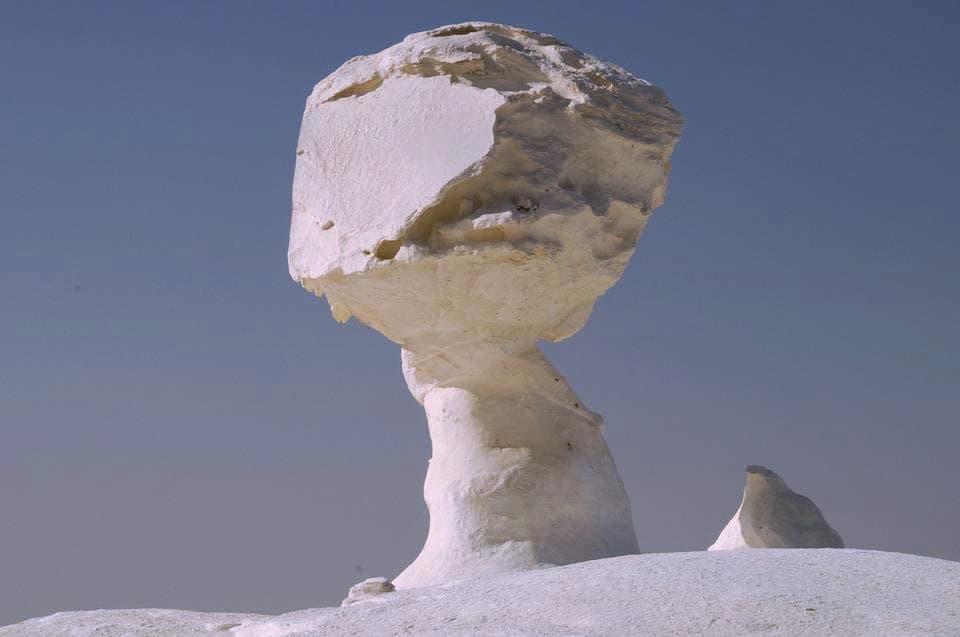
The White Desert is a natural Egyptian landmark.
The White Desert is a must-see national park in Egypt. The park has some of the most incredible and unique chalk rock formations, vast sand dunes, and impressive cliffs. The park is huge and it covers 1,160 sq mi (3,010 km2).
The White Desert is about 4 hour and a half drive from Cairo. The easiest way to see the White Desert is to take a guided day tour from Cairo.
EGYPT LANDMARKS MAP
Map of Egypt landmarks and attractions
BEST TIME TO VISIT EGYPT
The best time to visit Egypt is from October to April for the pleasant temperatures for sightseeing.
Summer in Egypt is extremely hot with daily average temperatures of around 95 F (35 C) in June, July, and August. Sometimes summer daily temperatures can reach even 115 F (46 C).
Autumn is a perfect time to visit Egypt with the daily average temperatures of around 86 F (30 C).
Winter is also a great time to visit Egypt with daily temperatures of around 70 F (21 C).
Spring is a good time to visit Egypt with daily average temperatures of around 83 F (28.5 C). But be prepared to encounter some possible sand storms in nature in Egypt in spring.
If you would like to visit these incredible landmarks in Egypt, the best time would be to travel to Egypt from October to April.
RECOMMENDED READ
Egypt (Lonely Planet Travel Guide)
The Complete Temples of Ancient Egypt
RECOMMENDED USEFUL TRAVEL ACCESSORIES FOR VISITING FAMOUS EGYPTIAN LANDMARKS
Water-resistant anti-theft day bag that charges your gadgets
Top-rated ultra-high capacity Anker portable charger
Canon G7 X Vlog Camera
Travel scarf with secret hidden pockets
Anti-Theft Rfid blocking travel wallet

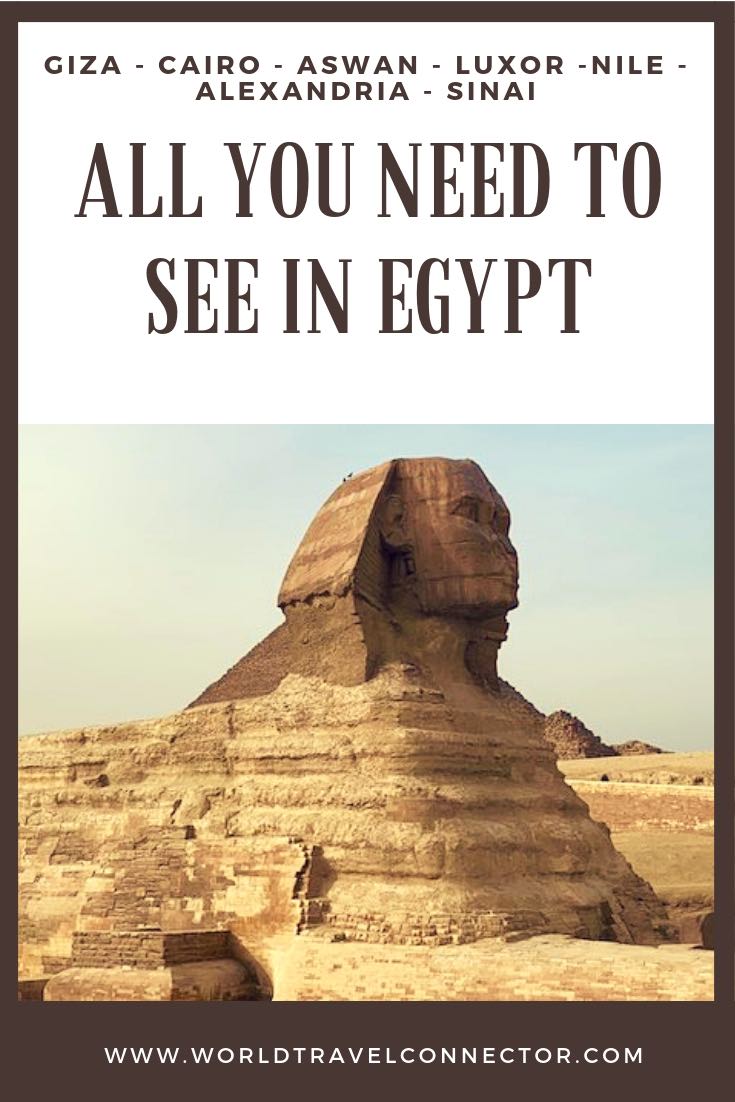
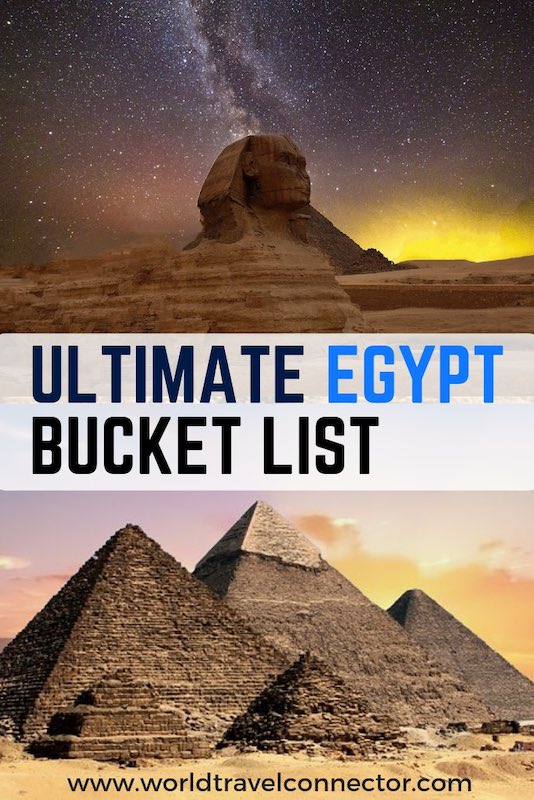
FAQ
What are the most famous landmarks in Egypt?
The most famous landmarks in Egypt are the Giza pyramids, the Great Sphinx, ancient Egyptian temples, and the Valley of the Kings.
What are natural landmarks in Egypt?
Natural landmarks in Egypt are the Nile River, Mount Sinai, and the White Desert.
What are the landmarks of ancient Egypt?
The landmarks of ancient Egypt are the Giza pyramids, the Great Sphinx of Giza, Abu Simbel temple, Karnak temple, Valley of the Kings, the Temple of Isis, the Temple of Kalabsha, the Temple of Edfu, the Temple of Hatshepsut, the Temple of Habu, temple of Kom Obo, Colossi of Memnon, Saqqara necropolis, and Memphis necropolis.
What famous monument was built in 2500 BCE?
The Great Pyramid of Giza (also called the Great Pyramid of Khufu, and the Pyramid of Cheops) is the oldest pyramid in Giza in Egypt. It was built around 2550 BCE.
- The Perfect One Day In Cordoba Itinerary: The Mezquita, Magical Patios, Mouthwatering Food & More! - April 18, 2025
- The Best Tuscany Road Trip Itinerary (Map & Tips 2025) - April 15, 2025
- Hands Down, These Are The Best Day Trips From Florence Italy - April 14, 2025

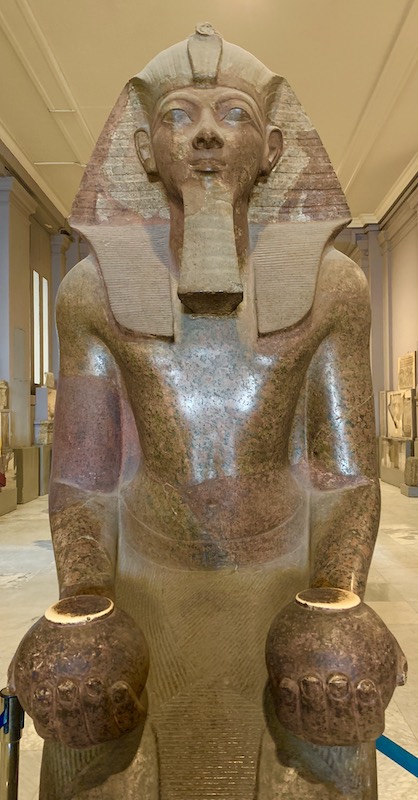
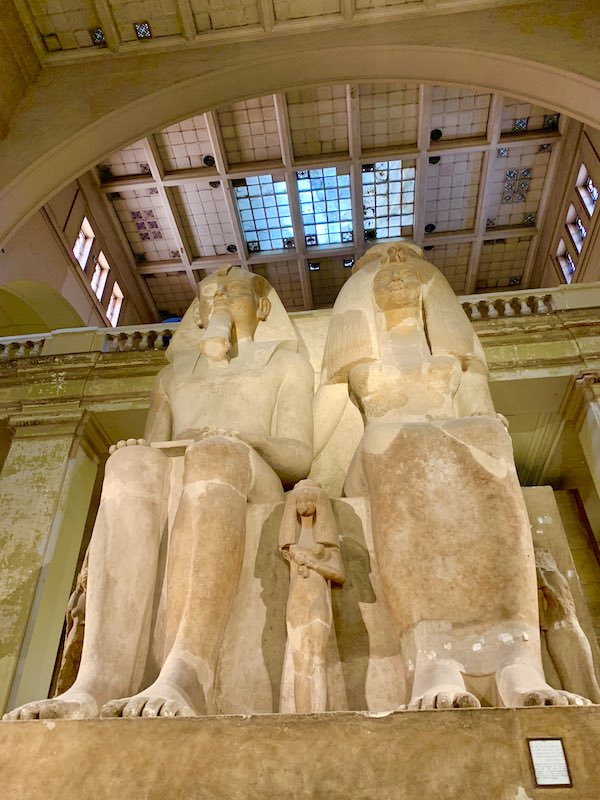
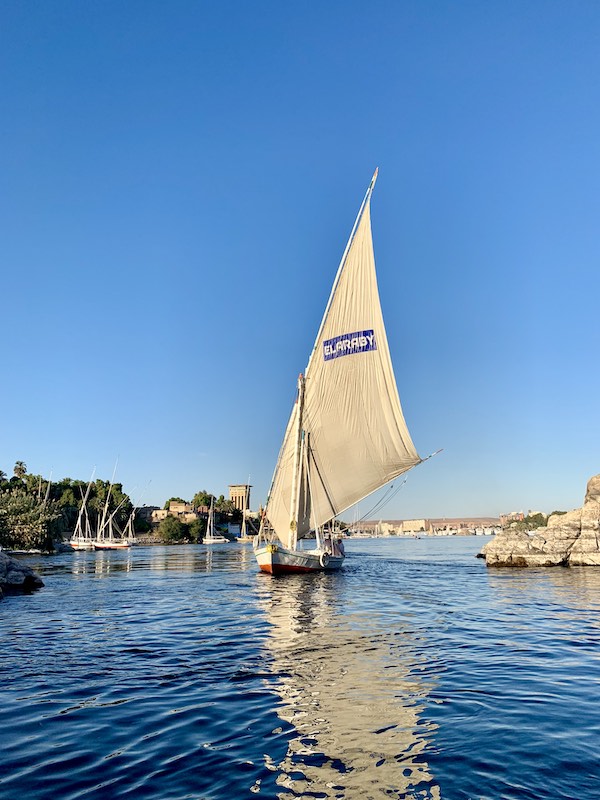
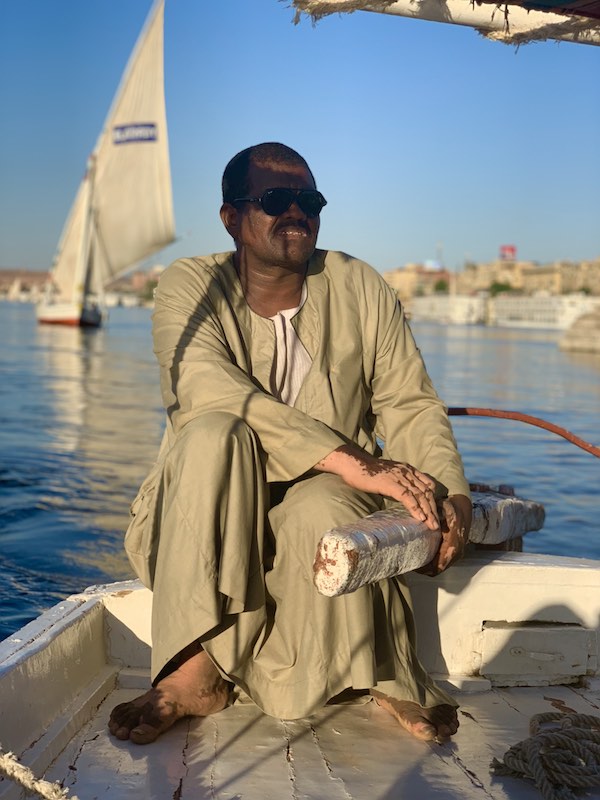

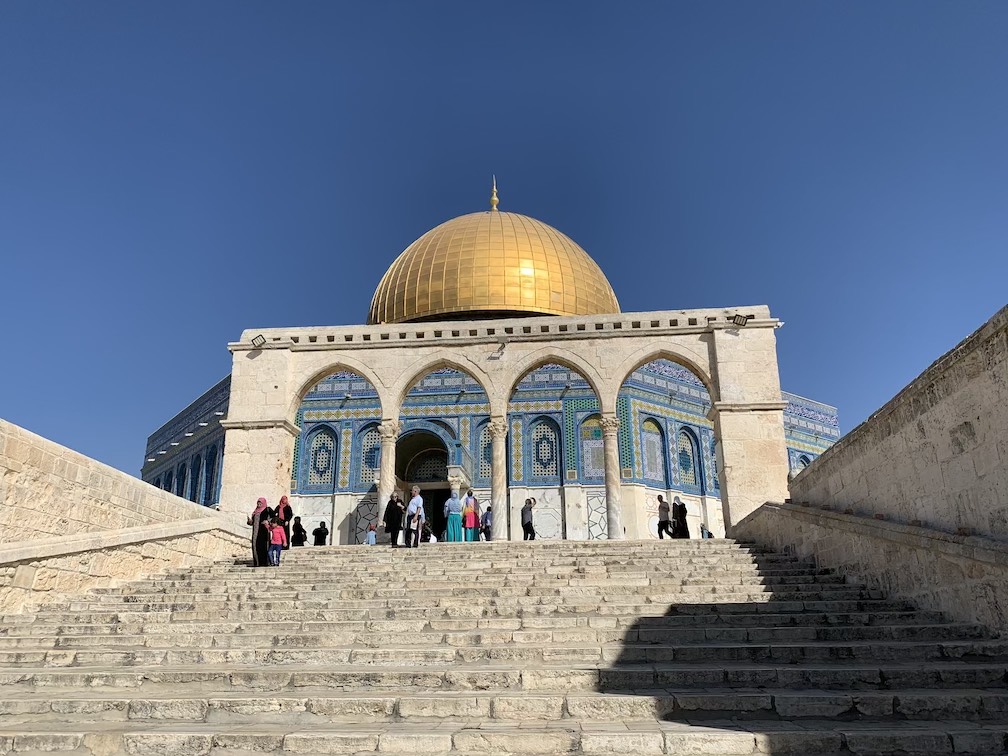
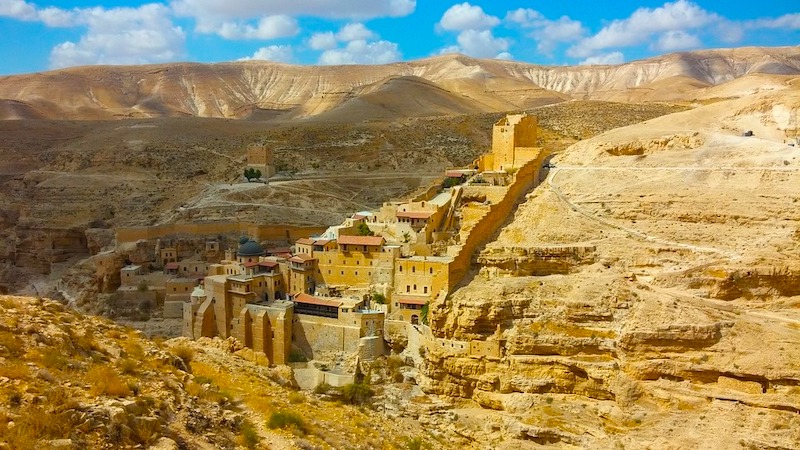
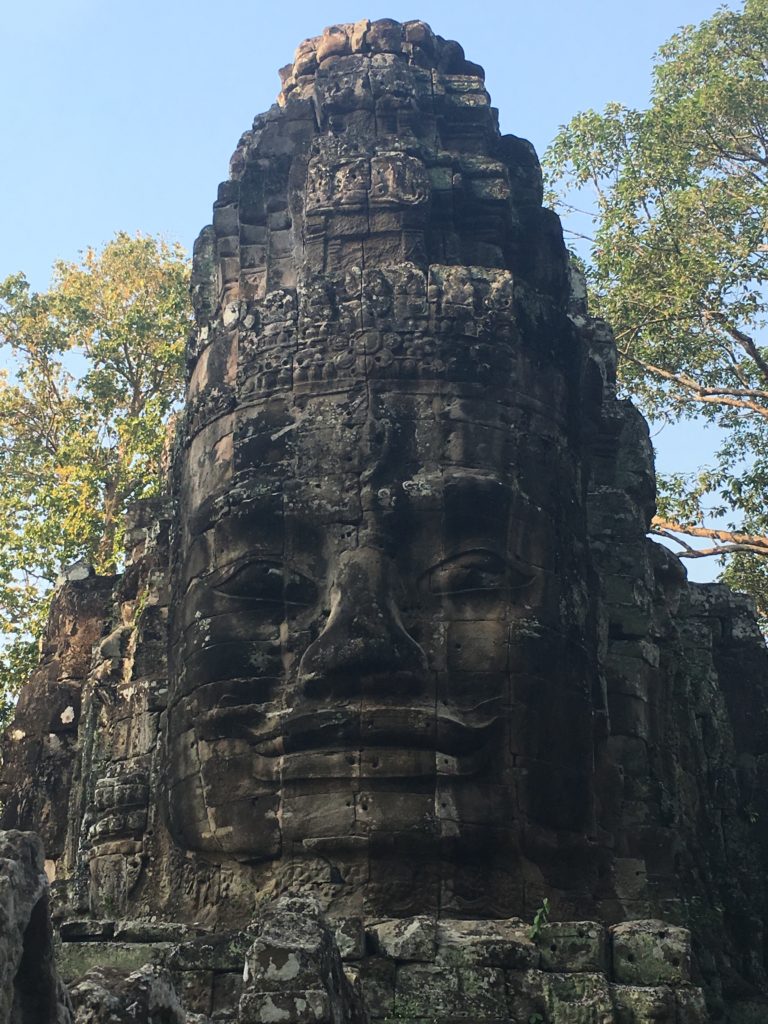
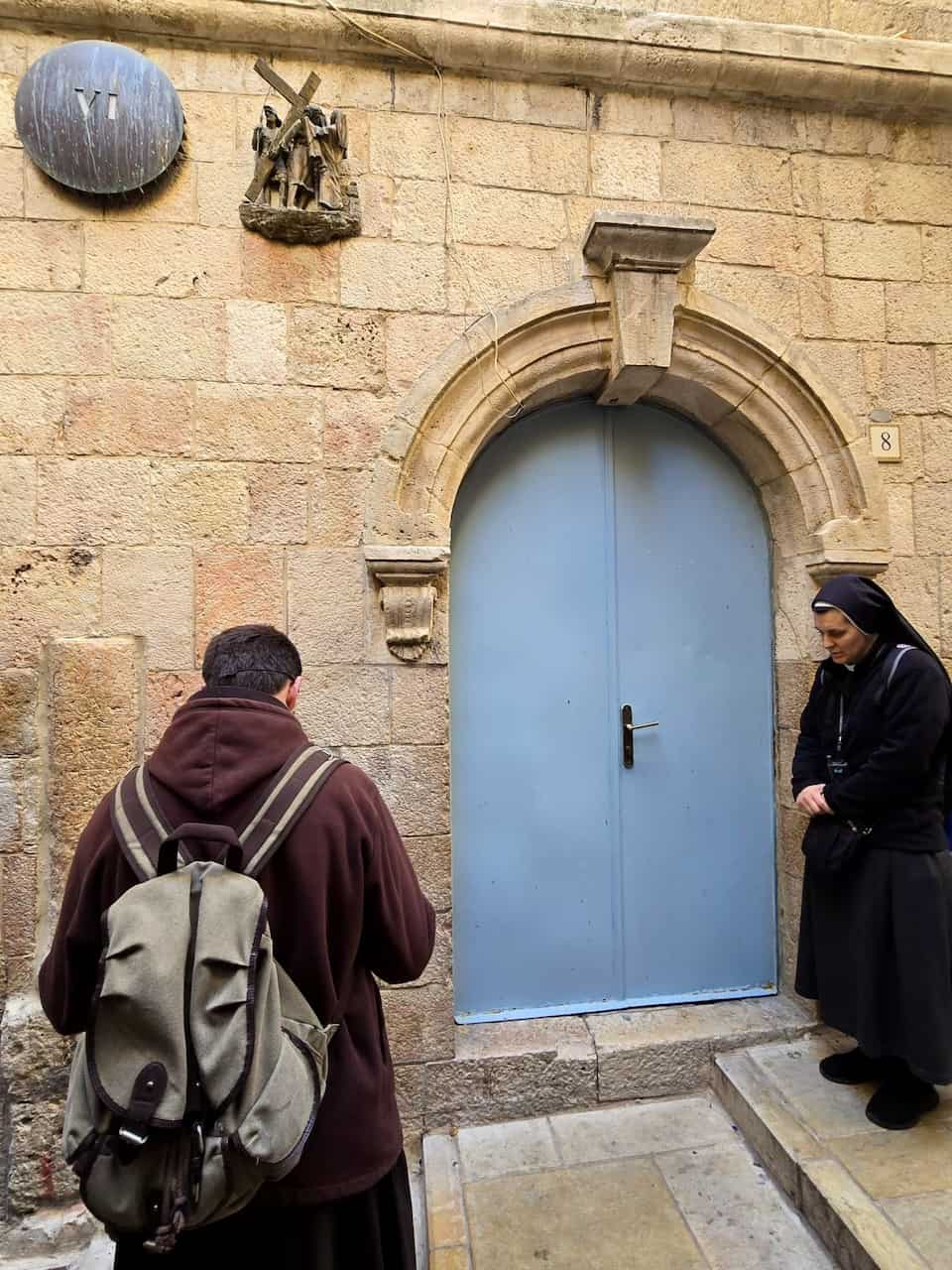
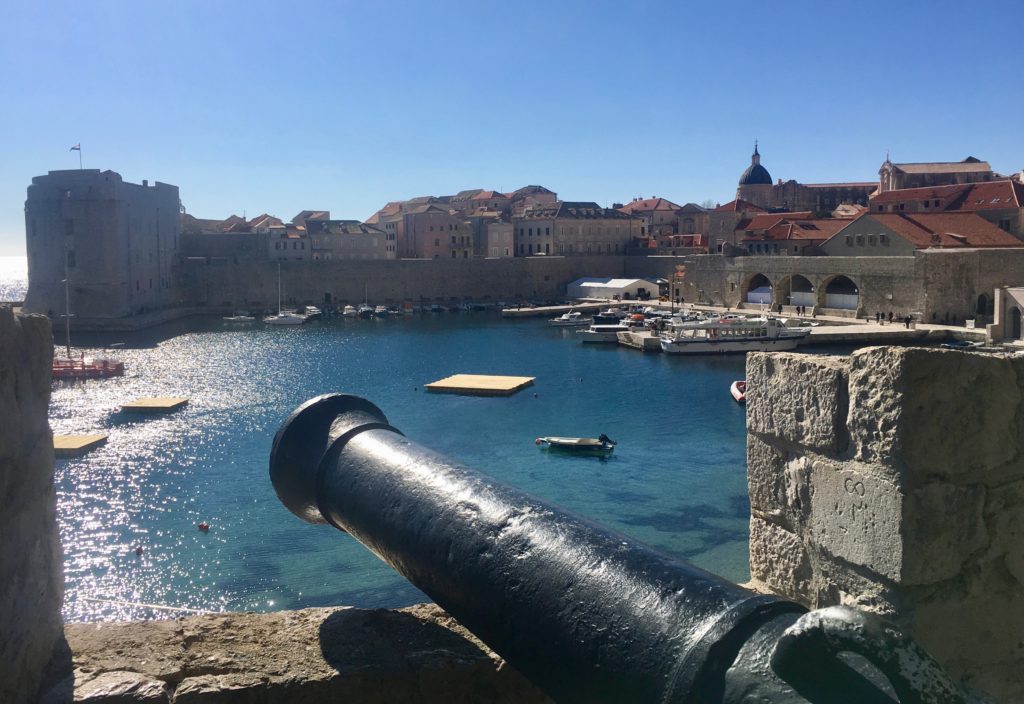
What an awesome recap of amazing places to visit in Egypt, which was always on my bucket list. If I ever do make it, this will be a great reference tool. I had no idea that the Great Pyramid of Giza is the only remaining wonder of the ancient world. I love being on the water so I especially liked the idea of sailing on the Nile.
What a thorough guide, a great reference for anyone who is looking to travel there. Definitely is on most people’s bucket list. Great photos! I especially like the first one on the camel.
We visited Egypt and we were so sad that our tour got changed and we did not get to Cairo or the Pyramids of Giza. And we missed the Sphinx too! I would definitely want to see the Egyptian Museum when we visit. But we did love to see Karnak, Medinet Habu and the Valley of the Kings. Even if we didn’t get a Nile River cruise. I guess we will just need to plan another visit to Egypt.
I have always wanted to go to Egypt I am saving this post it is a great guide about what to see. Your pictures are beautiful makes me want to visit even more.
Egypt is one destination our family would LOVE to visit! The fact that the structures and details of the buildings have withstood literally thousands of years of natural deterioration and still look breathtaking. I can’t wait to see them for myself.
We visited quite a lot of these whilst on a Nile cruise a few years ago and it really whetted our appetite to see so much more. We’re hoping to go back in a year or so and see the Pyramids and also revisit places like Karnak which we really loved.
Thank you for this post! I’ve visited Egypt when I was a child and I definitely want to come back as an adult Did you explore also Cairo city?
Did you explore also Cairo city?
Hey Giulia,
yes, I have visited Cairo too. Especially liked Coptic Cairo and learned much about Coptic Christians. Coptic Cairo deserves a separate post on my site. Hope to manage to write the post soon.
Happy New Year,
xoxo Milijana
Egypt is high on my bucket list and your travel post is book marked for future reference. I am going to visit all of them for sure however, Sphinx is my favorite. Its gigantic and photogenic. Temple of Horus is intriguing as usual. Karnak and Temple of Habu are new things for me and I will check this out.
Your post reminded me of all the reasons that I’m dying to visit Egypt. However, there were some spots I was unaware of like the Alexandria Library which looks so impressive!
True, pyramids are first on my mind as I haven’t been to Egypt yet and would like to go, but I know there is so much else besides those! Stinks you can’t take photos inside though. Sphynx is also high on my list and it’s good to know that’s an easy day trip from Cairo and that Uber is there! Also I love night photography and love the Kom Ombo at night. I would love to see the Alexandria Library and cruising the Nile is a bucket list item as is Mt Sinai. Question though-do they have the spot marked where they believe Moses was found in the basket? Do they show you that on sailings and/or cruises?
Hey Heather,
Moses is believed to be found on the site where today stands Ben Ezra Synagogue in Coptic Old Cairo.
I have visited the synagogue and Coptic Cairo while I was in Cairo. They are easily reached by metro in Cairo.
Happy New Year,
xoxo Milijana
Egypt is mostly known for the great pyramids but I would say that I love to visit the Alexandria library and also the library in Sinai monastery first. I just love exploring libraries, what more if it’s an old and ancient library! The Sphinx, Egyptian museum, Karnak temple and St Catherine monastery are one of my top picks too. Hopefully I can be able to visit Egypt soon! I will certainly not miss all of the sites in your list.
Egypt has always been on my bucket list. I would love to see the Pyramids of Giza in person! I had never heard of the Temple of Horus, but after looking at your pictures and reading your post, now I’m intrigued!
This absolutely fantastic. I have been wanting to go to Egypt for a while now but never found the time. Your comprehensive article has made me want to go there now. I have heard of all these places and read about them too except COLOSSI OF MEMNON.
 haha.
haha.
Even Egypt Museum seems interesting, considering that we are avid museum-avoiders
what an amazing recap of the epic places to visit in Egypt. Visiting Egypt and particularly visiting the Great Pyramid of Giza is a dream. When I was a kid I read a book about the Nile, it would be great to sail on the river. I am going to save your post for when I plan a visit Egypt
I’d love to visit Egypt one day! So much history!! I of course already knew about the pyramids and the sphinx, but I didn’t realize how many temples were open to visitors. And I would definitely want to visit the monastery at Mt. Sinai – how amazing!
Great post! I´ve been wanderlusting pretty seriously about Egypt for about a year now and am hoping to plan a trip including a Nile River cruise for 2019, so this was majorly inspirational for me! Love the shot of you with the sphinx as well, perfectly captured. It´s so easy to fixate on the pyramids, but there really is so much incredible history and so many incredible monuments in Egypt!
Egypt is always on my wishlist and thanks to you for putting up all the spectacular landmarks in one post. I would love to take Pyramids and Sphinx tour and also those iconic photos with them, which I see on Instagram daily.
I really enjoyed reading this post and I learned so much. I knew the basics of Egyptian history and the major landmarks of course, but this clarified and extended so much. I definitely want to visit Egypt and take in these places. I would not have thought about climbing Moses Mountain or visiting the library at Alexandria, but would definitely search them out now. It is a shame it is not possible to take photographs inside the pyramids, but that is not unusual in such places I suppose. Thank you for such an enlightening and interesting post.
Having never been to Egypt I want to see all of these places! So much history there and this post with everything in one place makes it really handy to have. Saving!
I Appreciate your great knowledge of our region and how you understand the division of regions such as the Middle East and the Maghreb region which has become synonymous with “North Africa”over the years for some reason and has confused many people about Egypt’s regional nature and when it comes to the Middle East. For some reason, People for the past couple of years have been confusing the Middle East, which is a geopolitical transcontinental region, with Western Asia. Also some think that the Middle East is a continent of its own lol. So some people can’t even grasp that Egypt, which is located in the African continent, is also in the Middle East as well. They think the two facts contradict because they lack the understanding of what the Middle East is and how it is a transcontinental region where its geographical territory is solely based on Shared politics, shared culture and shared history, rather than a shared continent. They don’t even know the context or the history of the original division between the Middle East and the Maghreb that was created by Arab Geographers and Historians in the Middle Ages such as Ibn Khaldun in order to divide the Berber western part of the Arab world aka the Maghreb(Libya, Algeria, Tunisia, and Morocco) from the Oriental/Eastern part of the Arab world(Egypt, the Levant, the Arabian Peninsula, Iraq) this was called the Mashriq .When the British created the new western terms for the same region between the 19th and 20th century(Middle East/Near East) they Added the non Arab countries as part of the region(Iran, Israel turkey and Cyprus).
Anyways, we need to make an end to this type of ignorance and we need more people like you who understand our region. Thank you.
Woh I like your blog posts, bookmarked! Perfect work you have done, this website is really cool with superb info.
I’m living in Egypt working for a tour company since 2000 and I have long experienced in tourism, I have had a lot of reading about Egypt, however your article is really interesting, thank you very much for your time writing that content.